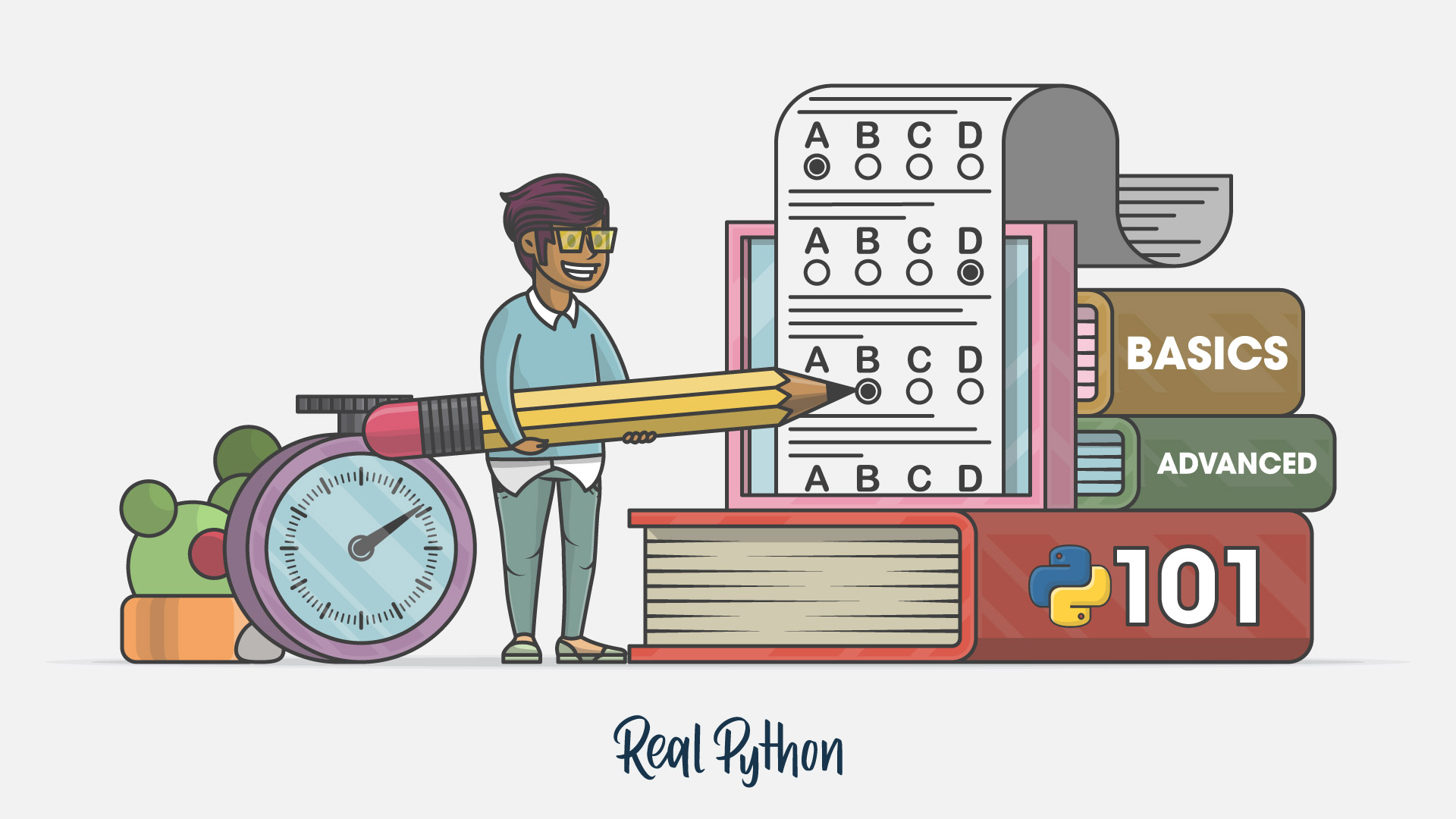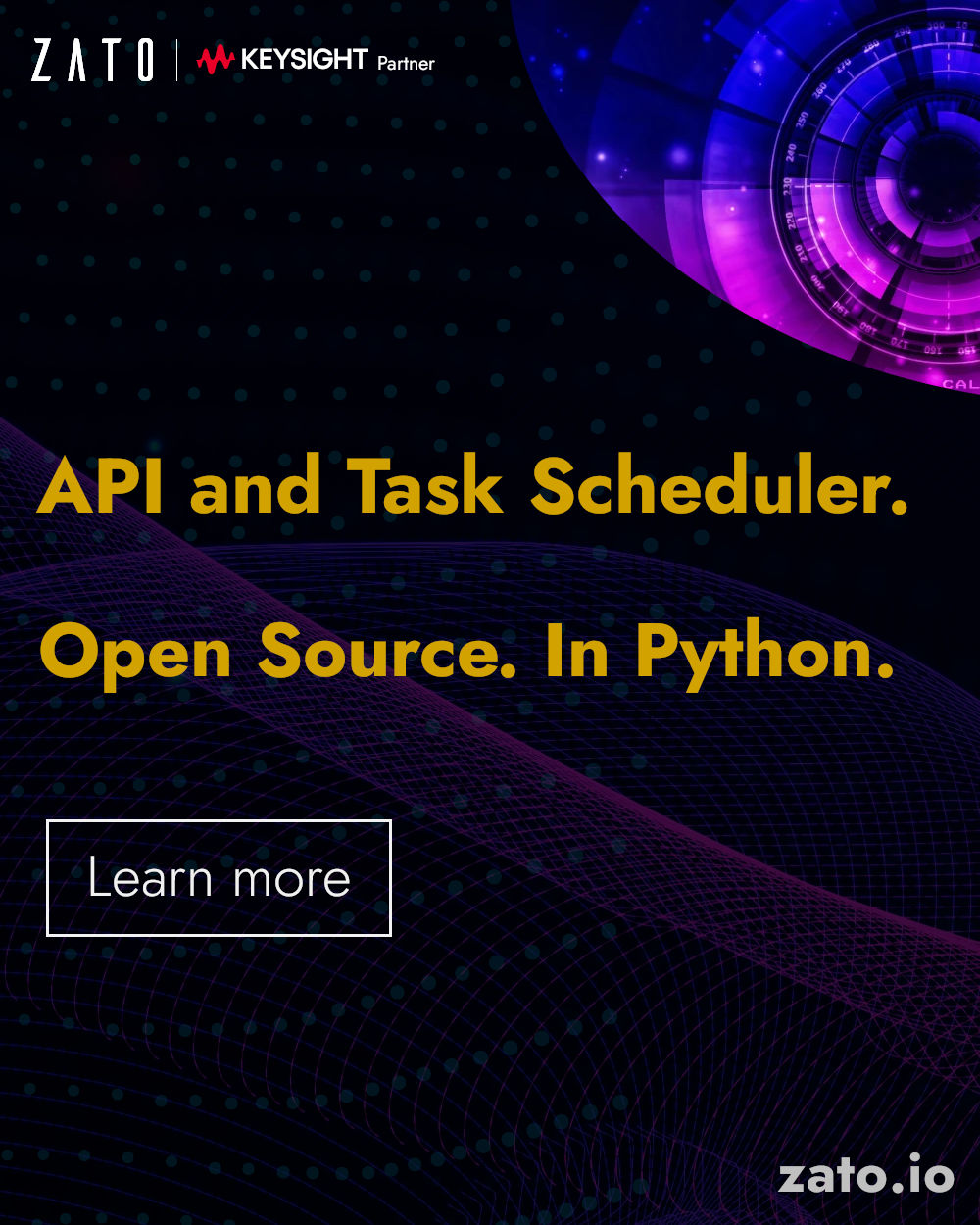Planet Python
Last update: January 11, 2026 07:43 PM UTC
January 10, 2026
EuroPython
Humans of EuroPython: Jakub Červinka
EuroPython wouldn’t exist if it weren’t for all the volunteers who put in countless hours to organize it. Whether it’s contracting the venue, selecting and confirming talks & workshops or coordinating with speakers, hundreds of hours of loving work have been put into making each edition the best one yet.
Read our latest interview with Jakub Červinka, a member of the EuroPython 2025 Operations Team and organizer of PyConCZ 2026.
Thank you for your service to EuroPython, Jakub!
 Jakub Červinka, member of the Operations Team at EuroPython 2025
Jakub Červinka, member of the Operations Team at EuroPython 2025EP: What first inspired you to volunteer for EuroPython?
The community has always been the biggest draw for me. Having volunteered at our local Python conference previously, I already knew how rewarding it is to be part of the organizing team. When the opportunity to join EuroPython came up, I jumped at it without a second thought. I really like connecting with organizers, speakers, and attendees from across the continent.
EP: What&aposs one task you handled that attendees might not realize happens behind the scenes at EuroPython?
One year I took on the role of “designated driver”, essentially the person who handles the last-minute, ad-hoc tasks that arise during the conference. It ranged from running out to buy a cart full of hygiene products for the bathrooms, to hauling cases of bottled water when we were about to run dry, to picking up emergency prints on one of the hottest days of the year. These are the kinds of small but critical jobs that keep everything running smoothly, and I enjoy making sure they get done.
EP: How did volunteering for EuroPython impact your relationships within the community?
In the best possible way. Over the years, I’ve built lasting friendships, met people I had only known from online talks and tutorials, and had the chance to become a familiar face in the community myself. Every EuroPython and every local conference strengthens those connections and leaves you with renewed energy and inspiration to keep contributing.
EP: What&aposs one thing you took away from the experience that you still use today?
The importance of recognition and appreciation. A simple “thank you” or “great job” from an attendee can mean a lot to volunteers. We’re doing important work, but it’s not our paid job. That experience has made me much more intentional about expressing gratitude to everyone who helps, whether they’re fellow volunteers, staff, or people in service roles.
EP: Do you have any tips for first-time EuroPython volunteers?
Don’t be afraid to ask questions or offer help, there’s always something that needs doing, and everyone can contribute in their own way. Keep an eye out for small improvements you could suggest, introduce yourself to people, and most importantly, enjoy the experience. Volunteering is as much about building relationships and having fun as it is about getting tasks done.
EP: Thank you, Jakub!
January 09, 2026
Mike Driscoll
How to Switch to ty from Mypy
Python has supported type hinting for quite a few versions now, starting way back in 3.5. However, Python itself does not enforce type checking. Instead, you need to use an external tool or IDE. The first and arguably most popular is mypy.
Microsoft also has a Python type checker that you can use in VS Code called Pyright, and then there’s the lesser-known Pyrefly type checker and language server.
The newest type checker on the block is Astral’s ty, the maker of Ruff. Ty is another super-fast Python utility written in Rust.
In this article, you will learn how to switch your project to use ty locally and in GitHub Actions.
Installation
You can run ty with uvx if you do not want to install it by using the following command in your terminal: uvx ty
To install ty with uv, run the following:
uv tool install ty@latest
If you do not want to use uv, you can use the standalone installer. Instructions vary depending on your platform, so it is best to refer to the documentation for the latest information.
Note: Technically, you can use pip or pipx to install ty as well.
Running ty Locally
Running with uv
uv run ty
Running without Installation
uvx ty
Running ty Directly
ty check
Configuring ty
- pyproject.toml
- ty.toml
There are many rules that you can change. Check out the documentation for full details.
In general, if you run mypy in strict mode, then running ty without changing any of its settings is very similar. However, ty currently does not highlight missing type hints. If you need to enforce adding type hints, you can use Ruff’s flake8-annotations.
Here is how to enable the flak8-annotations in your pyproject.toml file:

If you have other rules already selected, you can add “ANN” to the end of the list to enable it.
Running ty in GitHub Actions
.github/workflows/ty.yml
Make sure you include the leading period!
Next, inside your yaml file, you will add the following code:
name: ty
on:
pull_request:
types: [opened, synchronize, reopened, ready_for_review]
workflow_dispatch:
jobs:
build:
if: github.event.pull_request.draft == false
runs-on: self-hosted
steps:
- uses: actions/checkout@v3
- name: Install Python
uses: actions/setup-python@v4
with:
python-version: “3.12”
- name: Install dependencies
run: |
python -m pip install --upgrade pip
pip install ty==0.0.7
- name: Run ty
run: ty check
continue-on-error: false
Now, when your team opens a new PR in your project, it will automatically run ty against it. Feel free to update the Python version to the one you are using. Also note that this GitHub Action sets the ty version to 0.0.7, which you may need to update as newer releases become available.
Using ty with pre-commit
- https://github.com/NSPC911/ty-pre-commit
- https://github.com/JacobCoffee/ty-pre-commit
- https://github.com/hoxbro/ty-pre-commit
- https://github.com/allganize/ty-pre-commit
- https://foundry.fsky.io/vel/ty-pre-commit
When Astral supports pre-commit itself, you should update your pre-commit configuration accordingly.
However, for this tutorial, you can use that first link which tells you to add the following to your .pre-commit-config.yaml:

Now, when you commit a file locally, pre-commit will run ty to check it for you automatically.
Wrapping Up
Type checkers can be really helpful in finding subtle bugs in your Python code. However, remembering to run them before pushing your code can be difficult, so make your life easier by adding the type checker to your CI!
Have fun and happy coding!
The post How to Switch to ty from Mypy appeared first on Mouse Vs Python.
The Python Coding Stack
Parkruns, Python’s enumerate and zip, and Why Python Loops Are Different from Other Languages • [Club]
If you live in the UK, you’re probably familiar with the Parkrun tradition: a friendly 5k run held every Saturday morning in hundreds of parks across the UK. Runners range from Olympians to people trying to lose some weight. It’s a well-oiled format replicated across all 893 Parkrun locations.
And here’s how they deal with the finish line logistics. Runners don’t wear bibs with numbers. When they cross the finish line, they enter a “funnel” marked by plastic cones and are handed a token with their position number. They then proceed to another official, who scans their personal barcode, which runners carry in their pockets or on a wristband, and the position token they received a few seconds earlier. This process matches the runner with their finishing position.
What’s this got to do with Python loops? And how does it help us understand why Python does loops differently from other languages?
First step, let’s create the Parkrun funnel. I’ll just put the first five finishers in this example:
>>> funnel = [”Jonathan”, “Michael”, “Samantha”, “Jessica”, “Daniel”]Now, here’s something you definitely know already because it’s always one of the first things you’re taught when learning Python: Don’t loop through this list like this:
# Avoid this when coding in Python
>>> i = 0
>>> while i < len(funnel):
... name = funnel[i]
... print(name)
... i += 1
...
Jonathan
Michael
Samantha
Jessica
DanielThis style mimics how other languages may work: you manually define and increment the index. To be fair, most people who shift from other languages are more likely to write the following version at some point:
# Also best to avoid this in Python
>>> for i in range(len(funnel)):
... name = funnel[i]
... print(name)
...
Jonathan
Michael
Samantha
Jessica
DanielThis version may seem more Pythonic since it uses Python tools such as range(), but still fails to make the most of Python’s iteration protocol. The Pythonic way of looping through this list is the following:
>>> for name in funnel:
... print(name)
...
Jonathan
Michael
Samantha
Jessica
DanielA question that’s often asked but rarely answered is: Why is this version preferred over the other two? I’ll write another short post to answer this question soon as I want to keep these The Club posts short whenever possible. So, let me state just a few reasons (there are more) and then I’ll move on to my main topic for today.
It’s more readable
It’s more efficient (try timing the versions above using
timeit—remove theprint()calls first)It’s less prone to errors and bugs
It works with a broader selection of data structures, not just sequences
While you wait for my follow-up post on this, you can read more about Python’s Iterator Protocol, iterables, and iterators here:
But let’s move on.
Let’s say you want to print out the names alongside each runner’s position. You’d like the following output:
1. Jonathan
2. Michael
3. Samantha
4. Jessica
5. Daniel“Aha!” I’m often told by some learners, “This is when you need to use the for i in range(len(funnel)) idiom, since you need the index!”
Python’s for loop doesn’t explicitly use the index, so you don’t have access to the index within the for loop. Many revert to the non-Pythonic idioms for this.
But Python provides tools that let you stay within the pure Pythonic style. Python’s for loop needs an iterator—it will create one from the iterable you provide. All Python iteration needs iterators, not just for loops. Iterators are Python’s tool for any iteration.
And there are some bespoke iterators in Python that handle most of your iteration needs. I recently wrote a series about the itertools module. The itertools module contains many such tools. Here’s the series: The itertools Series.
But there are also two built-in tools that many forget, but are extremely useful. The first one is enumerate().
Here’s how you can use it to display the Parkrun results:
>>> for index, name in enumerate(funnel, start=1):
... print(f”{index}. {name}”)
...
1. Jonathan
2. Michael
3. Samantha
4. Jessica
5. DanielReal Python
The Real Python Podcast – Episode #279: Coding Python With Confidence: Beginners Live Course Participants
Are you looking for that solid foundation to begin your Python journey? Would the accountability of scheduled group classes help you get through the basics and start building something? This week, two members of the Python for Beginners live course discuss their experiences.
[ Improve Your Python With 🐍 Python Tricks 💌 – Get a short & sweet Python Trick delivered to your inbox every couple of days. >> Click here to learn more and see examples ]
January 08, 2026
Rodrigo Girão Serrão
Recursive structural pattern matching

Learn how to use structural pattern matching (the match statement) to work recursively through tree-like structures.
In this short article you will learn to use structural pattern matching in recursive, tree-like data structures.
The examples from this article are taken from a couple of recent issues of my weekly newsletter.
A recursive data structure
Structural pattern matching excels at... matching the structure of your objects! For the two examples in this article, we'll be using a number of dataclasses that you can use to build abstract Boolean expressions:
from dataclasses import dataclass
class Expr:
pass
@dataclass
class And(Expr):
exprs: list[Expr]
@dataclass
class Or(Expr):
exprs: list[Expr]
@dataclass
class Not(Expr):
expr: Expr
@dataclass
class Var(Expr):
name: strFor example, the code Not(And([Var("A"), Var("B")])) represents the Boolean expression not (A and B).
Evaluating a Boolean expression
Suppose you have a Boolean expression built out of the components shared above. How do you evaluate that formula if you are given the assignments that map the variables to their values?
For example, if you have the assignments {"A": True, "B": False} (for example, a dictionary that maps variable names to values), how can you determine that the expression Not(And([Var("A"), Var("B")])) is True?
This is where structural pattern matching can be applied recursively and it's where it really shines!
To solve this problem, you will write a function called evaluate(expression: Expr, assignments: dict[str, bool]) -> bool.
Your function accepts an expression and the assignments in the form of a dictionary and it returns the final Boolean value the expression evaluates to.
Since you're accepting an expression, you're going to use the match statement on the full expression and then create a case branch for each of the possible expressions you might have:
- a variable;
- an
Andexpression; - an
Orexpression; or - a
Notexpression.
The structure of the code looks like this:
def evaluate(expression: Expr, assignments: dict[str, bool]) -> bool:
match expression:
case Var(): pass
case And(): pass
case Or(): pass
case Not(): passThe trick here is realising that you're using Expr as the type of the argument but really, you always expect the argument to be an instance of one of the subclasses of Expr, and not a direct Expr instance.
However, to make sure you don't trip on a weird bug later on, and because this matching is supposed to be exhaustive – you're supposed to have one case for each subclass of Expr – you can defend yourself by including a catch-all pattern that raises an error.
When I'm being lazy, I just raise a RuntimeError:
def evaluate(expression: Expr, assignments: dict[str, bool]) -> bool:
match expression:
case Var(): pass
case And(): pass
case Or(): pass
case Not(): pass
case _:
raise RuntimeError(
f"Couldn't evaluate expression of type {type(expression)}."
)Now, it's just a matter of implementing the evaluation logic. In the case of a variable, all you have to do is fetch the variable value from the corresponding dictionary. However, to make it more convenient to...
Stéphane Wirtel
Automating TLS Certificate Monitoring with GitHub Actions, certificate_watcher, and Slack
Introduction
As a consultant constantly working with clients, I found myself in a familiar predicament: my head was always down, focused on delivering value to customers, but my own infrastructure monitoring was non-existent. I had no simple way to track SSL/TLS certificate expirations across the multiple domains I managed - personal sites, client projects, and community services.
I needed a solution, but I had several constraints:
- No time for complex setup: I couldn’t afford to spend days installing, configuring, and deploying yet another monitoring service
- Easy maintenance: Whatever I built had to be low-maintenance - I didn’t want another system to babysit
- Transparency and control: I wanted a simple text file in Git listing the hosts to monitor, so I could see exactly what was being checked and track changes over time
- Zero infrastructure: No servers to provision, patch, or pay for
Around this time, a friend named Julien shared his project called certificate_watcher, a lightweight Python tool for checking SSL certificate expiration. I contributed a few patches (if memory serves), and it clicked: what if I could combine this with GitHub Actions and Slack notifications?
January 07, 2026
Real Python
How to Build a Personal Python Learning Roadmap
If you want to learn Python or improve your skills, a detailed plan can help you gauge your current status and navigate toward a target goal. This tutorial will help you craft a personal Python learning roadmap so you can track your progress and stay accountable to your goals and timeline:
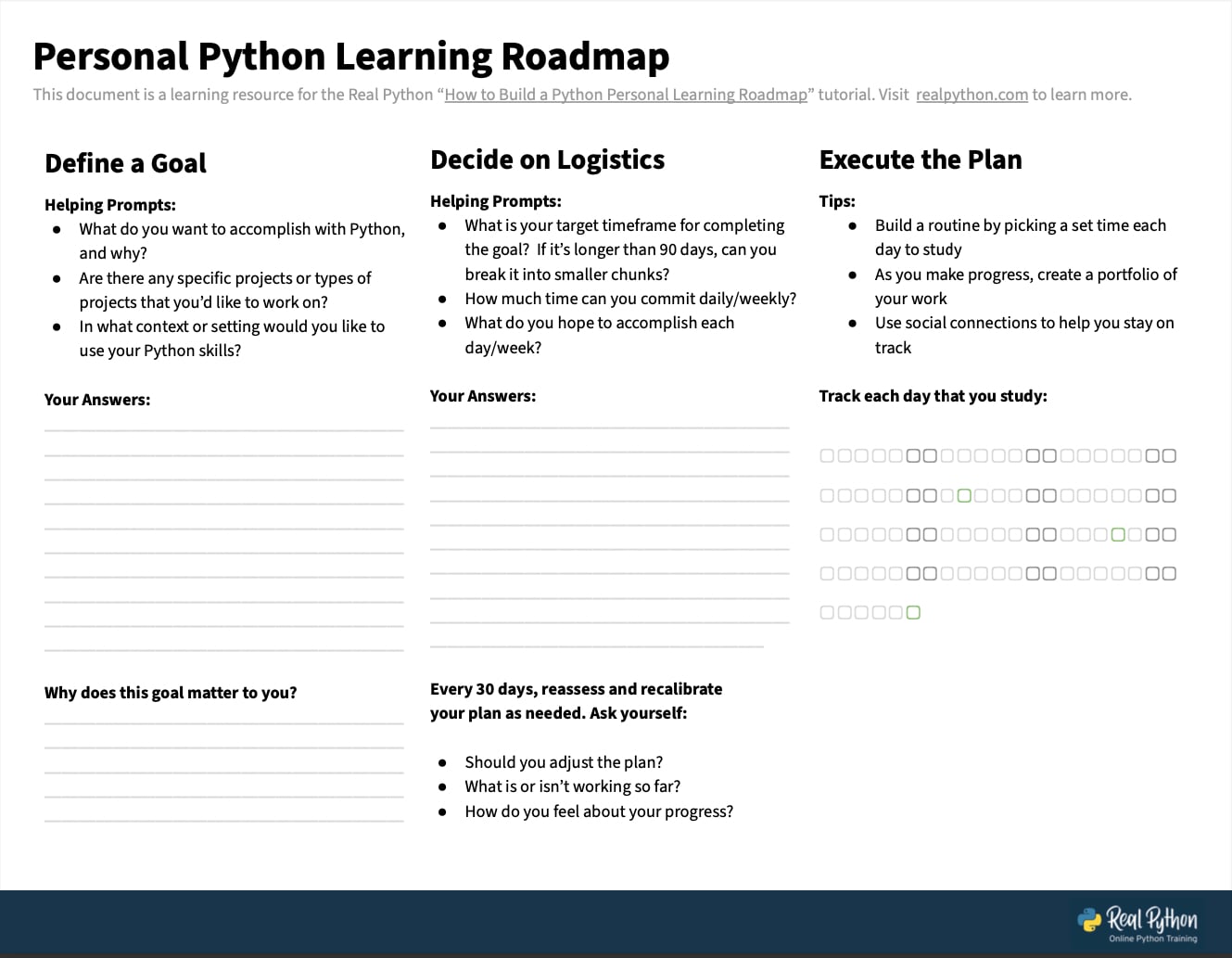
The steps in this tutorial are useful for Python developers and learners of all experience levels. While you may be eager to start learning, you might want to set aside an hour or two to outline a plan, especially if you already know your learning goals. If you don’t yet have clear goals, consider spreading that reflection over a few shorter sessions across several days to clarify your direction.
Before you start, gather a few practical tools to support building your plan. This might include a notebook, a calendar or planner (digital or physical), a list of projects or goals you want to work toward, and any Python books or online resources you plan to use.
Note: If you learn best with structure and accountability, you can also follow your roadmap inside a cohort-based live course delivered by Real Python experts, with weekly live classes and live Q&A.
You can download a Personal Python Learning Roadmap worksheet to help you create your plan by clicking the link below:
Get Your Python Learning Roadmap: Click here to download a free, fillable Python learning roadmap PDF to help you set your aims and track your progress.
This tutorial will guide you through the planning process, starting with clarifying what you want to achieve and why. From there, you’ll map out the practical steps that will turn your goals into a realistic, actionable roadmap.
Step 1: Define Your Goals and Motivation
To create an effective learning roadmap, you first need to know what you want to achieve and what your motivation is. For this step, you’ll consider the following reflection prompt:
What do I want to accomplish with Python, and why?
Taking the time to answer this question sets the foundation for every decision you’ll make as you build your roadmap.
Define Your Goals
Start by deciding what you want to accomplish with Python, then write it down. Research shows that this small step can make a meaningful difference. In a study conducted by psychology researcher Dr. Gail Matthews at Dominican University of California, participants who wrote down their goals were significantly more likely to achieve them than those who didn’t.
If you’re not sure yet about your goals, here are some questions for you to consider:
-
Are there specific projects—or types of projects—that you’d like to work on? For example, data analysis, game development, or building a web app.
-
In what context or setting would you like to use your Python skills? For example, at work, in school, or as part of a personal interest or side project.
Remember to write these answers down either in your notebook or on the Personal Python Learning Roadmap worksheet included in this tutorial’s downloads. Having them written down will provide helpful context as you continue formulating your roadmap.
Determine Your Motivation
Once you have a general goal in mind, think about why you want to achieve it. Your motivation plays a key role in whether you’ll stick with your plan over time. As clinical psychology professor Dr. Jennifer Crawford explains:
If we don’t care about why we’re doing [a goal], then it makes it really difficult to stick with that new behavior.
— Dr. Jennifer Crawford
She also encourages goal-setters to ask how their goals connect with something that’s important to them.
This idea is echoed by psychology professor Angela Duckworth in her book Grit, where she emphasizes that a strong sense of purpose helps you persevere when you encounter obstacles that might otherwise derail your progress.
Some possible reasons behind your “why” might include:
- A personal interest or a love of learning
- A desire to start or advance a career in software development
- A goal of earning a computer science degree
- An interest in volunteering your skills—for example, creating a Python application that supports a cause you care about
As you consider your motivation, see if you can dive deeper into the root of your reasons. A deeper look can add even more meaning and staying power to your goals. For example:
Read the full article at https://realpython.com/build-python-learning-roadmap/ »
[ Improve Your Python With 🐍 Python Tricks 💌 – Get a short & sweet Python Trick delivered to your inbox every couple of days. >> Click here to learn more and see examples ]
Stéphane Wirtel
dsmtpd 1.2.0: Test Your Emails Risk-Free
The Test Email That Never Should Have Been Sent
You know that feeling? You’re developing a new email feature, you run your test script, and boom — you realize 3 seconds too late that you used the production database. Your CEO just received an email with the subject “TEST - DO NOT READ - LOREM IPSUM”.
Or worse: you configured a cloud SMTP server for testing, forgot to disable actual sending, and now your Mailgun account is suspended for “suspicious activity” because you sent 847 emails to test@example.com in 5 minutes.
Python⇒Speed
Unit testing your code's performance, part 1: Big-O scaling
When you implement an algorithm, you also implement tests to make sure the outputs are correct. This can help you:
- Ensure your code is correct.
- Catch problems if and when you change it in the future.
If you’re trying to make sure your software is fast, or at least doesn’t get slower, automated tests for performance would also be useful. But where should you start?
My suggestion: start by testing big-O scaling. It’s a critical aspect of your software’s speed, and it doesn’t require a complex benchmarking setup. In this article I’ll cover:
- A reminder of what big-O scaling means for algorithms.
- Why this is such a critical performance property.
- Identifying your algorithm’s scalability, including empirically with the
bigOlibrary. - Using the
bigOlibrary to test your Python code’s big-O scalability.
January 06, 2026
PyCoder’s Weekly
Issue #716: Performance Numbers, async Web Apps, uv Speed, and More (Jan. 6, 2026)
#716 – JANUARY 6, 2026
View in Browser »
PyCoder’s Weekly 2025 Top Articles & Hidden Gems
PyCoder’s Weekly included over 1,500 links to articles, blog posts, tutorials, and projects in 2025. Christopher Trudeau is back on the show this week to help wrap up everything by sharing some highlights and uncovering a few hidden gems from the pile.
REAL PYTHON podcast
Python Numbers Every Programmer Should Know
Ever wonder how much memory an empty list takes? How about how long it takes to add two integers in Python? This post contains loads of performance data for common Python operations.
MICHAEL KENNEDY
Webinar: Building Deep Agents with Scale AI & Temporal

Build AI agents that don’t stop running. Join Scale AI and Temporal to learn how Agentex and Python enables long-running, fault-tolerant agents with human-in-the-loop workflows, plus a live procurement agent demo →
TEMPORAL sponsor
What async Really Means for Your Python Web App?
Python continues to get better async support and with that comes pressure to switch. See the realistic effects that switching to async would have on your web servers.
ARTEM CHERNYAK
How uv Got So Fast
uv’s speed comes from engineering decisions, not just Rust. Static metadata, dropping legacy formats, and standards that didn’t exist five years ago.
ANDREW NESBITT
Articles & Tutorials
Python 3.6-3.14 Performance
One of the maintainers of Knave has been tracking Python performance data for a while and a recent upgrade of one of their machines meant they now had more info across different hardware. This post compares their performance test across Apple M1 & M5, Zen2 and Cascade Lake chips.
CREWTECH
Static Protocols in Python: Behaviour Over Inheritance
Static protocols bring structural typing to Python: type compatibility based on behaviour, not inheritance. This article explains how protocols differ from ABCs, goose typing, and classic duck typing, and how static type checkers use them to catch errors early.
PATRICKM.DE • Shared by Patrick Müller
Get Job-Ready With Live Python Training
Real Python’s 2026 cohorts are open. Python for Beginners teaches fundamentals the way professional developers actually use them. Intermediate Python Deep Dive goes deeper into decorators, clean OOP, and Python’s object model. Live instruction, real projects, expert feedback. Learn more at realpython.com/live →
REAL PYTHON sponsor
How to Build Internal Developer Tools With a Small Team
This opinion piece talks about how to build internal dev tools. It provides a mental model of product engineering to help decide whether to prioritise improving stability or adding new features.
PATRICKM.DE • Shared by Patrick Müller
How to Securely Store Secrets in Environment Variables
You shouldn’t store API keys, tokens, or other secrets with your code, they need to be protected separately. In this post, Miguel discusses how he handles secrets with environment variables.
MIGUEL GRINBERG
2025 Python Year in Review
Talk Python interviews Barry Warsaw, Brett Cannon, Gregory Kapfhammer, Jodie Burchell, Reuven Lerner, and Thomas Wouters and the panel discusses what mattered for Python in 2025.
TALK PYTHON podcast
Python Supply Chain Security Made Easy
Learn how to integrate Python’s official package scanning technology into your processes to help ensure the security of your development environment.
MICHAEL KENNEDY
PyPI in 2025: A Year in Review
Dustin summarizes all the happenings with the Python Packaging Index in 2025, including 130,000 new projects and over 2.5 trillion requests served.
DUSTIN INGRAM
Top Python Libraries of 2025
Explore Tryo-labs’ 11th annual Top Python Libraries roundup, featuring two curated Top 10 lists: one for General Use and one for AI/ML/Data tools.
DESCOINS & BELLO
Implicit String Concatenation
Python automatically concatenates adjacent string literals thanks to implicit string concatenation. This feature can sometimes lead to bugs.
TREY HUNNER
Safe Django Migrations Without Server Errors
How to run schema-changing Django migrations safely, avoiding schema/code mismatches and server errors during rolling deployments.
LOOPWERK
Projects & Code
vresto: Interface for Copernicus Sentinel Data
An elegant Python interface for discovering and retrieving Copernicus Sentinel data.
GITHUB.COM/KALFASYAN • Shared by Yannis Kalfas
Liberty Mail: Email Client for Sales Outreach
GITHUB.COM/EYEOFLIBERTY • Shared by [Ivan Kuzmin]
Events
Weekly Real Python Office Hours Q&A (Virtual)
January 7, 2026
REALPYTHON.COM
Python Atlanta
January 9, 2026
MEETUP.COM
PyDelhi User Group Meetup
January 10, 2026
MEETUP.COM
DFW Pythoneers 2nd Saturday Teaching Meeting
January 10, 2026
MEETUP.COM
PiterPy Meetup
January 13, 2026
PITERPY.COM
Leipzig Python User Group Meeting
January 13, 2026
MEETUP.COM
Happy Pythoning!
This was PyCoder’s Weekly Issue #716.
View in Browser »
[ Subscribe to 🐍 PyCoder’s Weekly 💌 – Get the best Python news, articles, and tutorials delivered to your inbox once a week >> Click here to learn more ]
Django Weblog
Django bugfix releases issued: 5.2.10, 6.0.1
Today we've issued the 5.2.10 and 6.0.1 bugfix releases.
The release packages and checksums are available from our downloads page, as well as from the Python Package Index.
The PGP key ID used for these releases is Jacob Walls: 131403F4D16D8DC7
Real Python
Tips for Using the AI Coding Editor Cursor
Cursor is an AI-powered integrated development environment (IDE) based on the Visual Studio Code codebase. It comes with a multi-agent interface and the Composer model for fast, agentic coding while keeping a familiar editor workflow with project-aware chat, code completion, and inline edits.
In this course, you will:
- Understand why Cursor might work for you
- Learn how to use different modes & models
- See how to run multiple agents at a time
- Resolve a tiny merge conflict
- Run a project and fix a bug
- Learn commands and practice with the terminal
[ Improve Your Python With 🐍 Python Tricks 💌 – Get a short & sweet Python Trick delivered to your inbox every couple of days. >> Click here to learn more and see examples ]
Seth Michael Larson
“Food JPEGs” in Super Smash Bros & Kirby Air Riders
Have you ever noticed that the food graphics in Super Smash Bros. and Kirby Air Riders is flat “billboarded” stock images of food?
This artistic decision from director Masahiro Sakurai has persisted through 8 games over nearly 25 years. I've seen a few folks online remarking about the “JPEG” or “PNG”-like quality of the images in the most recent release: Kirby Air Riders.
While researching every game with this art style and all 150+ unique food images I ended up fixing wikis, reviewing a seasonal KitKat flavor, and preserving an uncatalogued image of tempura soba.

Burgers from Super Smash Bros. Melee (2001), Kirby Air Ride (2003), Super Smash Bros. Brawl (2008), Super Smash Bros. Ultimate (2018), and Kirby Air Riders (2025).
Masahiro Sakurai is the director for every game on this list, so clearly this is his artistic decision. Super Smash Bros. Melee was the first game to contain this food art style, published in 2001. This style was then repeated in Kirby Air Ride (2003), Super Smash Bros. Brawl (2008), Super Smash Bros. for 3DS and Wii U (2014), Super Smash Bros. Ultimate (2018), and most recently in Kirby Air Riders (2025).
Credit to Nintendo, HAL Laboratories, SORA Ltd., and Bandai Namco Studios as developers and publishers of these games. Artwork was sourced from the Spriters Resource.
Super Smash Bros. Melee (2001)




























Where it all began! Super Smash Bros. Melee for the GameCube started off with 28 distinct food items, often found in “Party Balls”. Each type of food had a different “nutritional value” and “yumminess quotient” according to the in-game trophy dedicated to the food items.
Melee included many foods specific to Japanese cuisine, such as unagi (eel), omurice, soba, dango, and gyūdon. I do distinctly remember growing up as a “culinarily sheltered” kid in the midwest United States and not understanding what many of these food items were.
The original stock images of Super Smash Bros. Melee and the next game, Kirby Air Ride, have been partially discovered and documented by a group called “Render96”. The stock images are from a company called “Sozaijiten”. Many of the food images come from Material Dictionary CDs Volume 14 (Vegetables & Fruits), Volume 22 (Food & Dishes), and Volume 73 (Cooking Japanese, Western, & Chinese). The apple stock image in particular was re-used all the way through Super Smash Bros. Ultimate (2018). The burger, milk, dango, and donut are still missing their primary source.
Kirby Air Ride (2003)












Kirby Air Ride for the GameCube had significantly fewer distinct food items (12) compared to Melee and maintained many of the same food stock images from Melee, including the apple, burger, chicken, curry, omurice, onigiri, and ramen. Nigiri was included, but the image was changed from a sushi board to a plate.
The stock images had their saturation increased and the black borders around the images are thicker, sometimes 2-3 pixels instead of only 1 pixel for Melee.

I paid $50 plus shipping on eBay for this PNG. This is the closest I'll get to NFTs.
While researching the foods in Kirby Air Ride I discovered a wiki description of a “tempura soba” item that I'd never heard of and wasn't included in the Spriters Resource spritesheets for Kirby Air Ride. Turns out that this item was changed to a “hotdog” in the NSTC-M and PAL releases of Kirby Air Ride.
I was unable to find a non-blurry image of the tempura soba sprite online, so of course I had to preserve this sprite myself. I purchased a Japanese copy of Kirby Air Ride, dumped the ROM using the FlippyDrive Disc Backup Utility, and ran the ROM using Dolphin with “Dump Textures” mode enabled to archive the sprite directly from the game.


Kirby Air Ride cover artwork (left: JP, right: US, PAL). Images from the GameTDB.
In the process I also learned that the cover of Kirby Air Ride changed between the Japanese and international releases. The Japanese cover art features a smiling happy Kirby where the international cover has Kirby with a furrowed brow and serious look.
Super Smash Bros. Brawl (2008)





























Super Smash Bros. Brawl for the Wii has only one more food item compared to Melee (29) and introduces 11 new food items including bread, cake, candy, chocolate, cookie, melon soda, parfait, peaches, pie, pineapple, and steak.
About half of the Japanese-specific foods from both Melee and Kirby Air Ride were replaced: curry, omurice, onigiri, and ramen.
The art is less saturated and more “realistic” which is in-line with the rest of the game's art direction. The images lost their black outline, likely to draw less attention to the “arcade-y” feel that the previous titles had with food items.
Super Smash Bros 3DS and Wii U (2014)





























Super Smash Bros. Wii U and 3DS have the same total number of food items as Brawl (29). These games change the food art style completely, again! It's brighter, saturated, and looks delicious.
The soda item was changed from a melon cream soda to a dark cola with lemon. The omurice was changed to a pair of fried eggs with bacon. These games are also the only ones without the “burger” food item.
Super Smash Bros. for 3DS uses the same food artwork used in Super Smash Bros. for Wii U downscaled to 64x64 pixels from 256x256 pixels with some minor editing.


Super Smash Bros. Wii U and 3DS added the “Mont Blanc” food item, which is a French dessert that is popular in Japan. I've seen multiple guides and wikis mistakenly label this food item as “noodles” due to the “vermicelli” shape of the puréed chestnuts. Yummy!
While researching and writing this blog post I happened across “Mont Blanc”-flavored KitKats. These are apparently a limited-time flavor for autumn. The KitKats are creamy and have plenty of chestnut flavor, but they are very sweet (apparently Mont Blanc is quite sweet, too, so this is to be expected).

Mont Blanc food item from Super Smash Bros Wii U, 3DS, and Ultimate
“Mont Blanc flavored limited-time KitKats”
Super Smash Bros. Ultimate (2018)






































Super Smash Bros. Ultimate uses the same 29 foods from the Wii U and 3DS and adds 9 more foods for a total of 38. Many of the newly added foods are call-backs to food items in previous titles, below highlighted in pink.
The 9 new foods in Ultimate are burgers, cheese, corndogs, donuts, dumplings, daisies, pizza, pineapple, and steak.
It's clear that the “Sozaijiten” stock images were still in use even in 2018: 17 years later! The apple, cheese, and chicken stock images for Super Smash Bros. Melee match the stock images used in Ultimate.
Kirby Air Riders (2025)































Kirby Air Riders released for the Switch 2 has the most foods of any game with this art style with 45 distinct food items.
Massive thank-you to Charles Bernardo for sending me carefully cropped images of the food in Kirby Air Riders.
Kirby Air Riders is the first game in this series to use completely new models for all food items: not even the apple or cheese are the same from any previous game. Kirby Air Riders is also the first game in this series not to have a “roast chicken” item, breaking from an established video-game food trope.














Kirby Air Riders adds a new food-centric mode called “Gourmet Race” where riders earn points by consuming food as quickly as possible in a small arena. Gourmet Race introduces a new food concept: “Large Foods”. Large food items are worth 15 points instead of 1 point per food item. There are 14 large food items, some presenting as “upgraded” versions of regular-sized foods.
The large food items are: a bunch of 12 bananas instead of 3, a bread-basket, a double cheeseburger, a whole cake instead of a slice, donuts, a fruit basket, a board of nigiri instead of a plate, fruit parfait, pizza, popcorn, salad, rainbow shave ice instead of blue only, a tempura bowl, and a whole watermelon instead of a slice.
Prior to this article there was not yet a complete list of foods in Kirby Air Riders documented on a wiki or spritesheet. I added this list to the Kirby wiki, but I've also included the list below:
List of food items in Kirby Air Riders
- Apple
- Bananas
- Bread Basket
- Cabbage
- Cake (Slice)
- Cake (Whole)
- Cheese
- Cheeseburger
- Cheeseburger (Double)
- Chocolate
- Cola
- Cupcake
- Donuts
- Dumpling
- Omurice
- French Fries
- Fried Rice
- Fruit Basket
- Gelatin
- Grapes
- Hamburg Steak
- Hotdog
- Icecream
- Jelly Beans
- Melon Cream Soda
- Nigiri (Plate)
- Nigiri (Board)
- Orange
- Orange Juice
- Pancakes
- Parfait
- Spaghetti
- Pizza
- Popcorn
- Ramen
- Salad
- Sambusas
- Sandwich
- Shave Ice (Blue)
- Shave Ice (Rainbow)
- Prime Rib Steak
- Tempura Bowl
- Watermelon (Slice)
- Watermelon (Whole)
Unique food items
















There are 16 total food items that only appear in a single title across the 25-year span of games. Kirby Air Riders and Super Smash Bros. Melee have by far the most unique food items with 8 and 5 respectively.
| Game | Count | Foods |
|---|---|---|
| Super Smash Bros. Melee | 5 | Dango, Gyūdon, Mushroom, Soba, Unagi |
| Kirby Air Ride | 0 | |
| Super Smash Bros. Brawl | 1 | Cookie |
| Super Smash Bros. Wii U/3DS | 0 | |
| Super Smash Bros. Ultimate | 2 | Daisy, Corndog |
| Kirby Air Riders | 8 | Cabbage, Cupcake, French Fries, Fruit Basket, Gelatin, Jelly Beans, Sambusas, Sandwich |
Comparing food across games
Finally, here is a table with every image so you can compare how each changed across different titles:
| SSB Melee 2001 |
Kirby Air Ride 2003 |
SSB Brawl 2008 |
SSB Wii U/3DS 2014 |
SSB Ultimate 2018 |
Kirby Air Riders 2025 |
|
|---|---|---|---|---|---|---|
| Apple |  |  |  |  |  |  |
| Bananas |  |   | ||||
| Bread |  |  |  |  | ||
| Burger |  |  |  |  |   | |
| Cabbage |  | |||||
| Cake |  |  |  |   | ||
| Candy |  |  |  | |||
| Cheese |  |  |  |  | ||
| Cherries |  |  | ||||
| Chicken |  |  |  |  |  | |
| Chocolate |  |  |  |  | ||
| Cola |  |  |  | |||
| Cookie |  | |||||
| Corndog |  | |||||
| Cupcake |  | |||||
| Curry |  |  | ||||
| Daisy |  | |||||
| Dango |  | |||||
| Donut |  |  |  |  | ||
| Dumplings |  |  | ||||
| Eggs |  |  |  |  |  | |
| Fried Rice |  |  |  | |||
| Fries |  | |||||
| Fruit Basket |  | |||||
| Gelatin |  | |||||
| Grapes |  |  |  |  |  | |
| Gyūdon |  | |||||
| Hamburg Steak |  |  |  | |||
| Hotdog |  |  |  |  |  | |
| Icecream |  |  |  |  | ||
| Jellybeans |  | |||||
| Kebab |  |  | ||||
| Kiwi |  |  | ||||
| Lemons |  |  | ||||
| Melon |  |  | ||||
| Melon Soda |  |  | ||||
| Milk |  |  |  |  | ||
| Mont Blanc |  |  | ||||
| Mushroom |  | |||||
| Nigiri |  |  |  |   | ||
| Onigiri |  |  |  |  | ||
| Orange |  |  | ||||
| Orange Juice |  |  |  | |||
| Pancakes |  |  |  | |||
| Parfait |  |  | ||||
| Pasta |  |  |  |  | ||
| Peach |  |  |  | |||
| Pear |  |  | ||||
| Pie |  |  |  | |||
| Pineapple |  |  | ||||
| Pizza |  |  |  |  | ||
| Popcorn |  |  |  | |||
| Ramen |  |  |  | |||
| Salad |  |  |  | |||
| Sambusas |  | |||||
| Sandwich |  | |||||
| Shave Ice |   | |||||
| Shumai |  |  |  | |||
| Soba |  | |||||
| Soup |  |  | ||||
| Steak |  |  |  | |||
| Strawberry |  |  | ||||
| Tea |  |  |  |  | ||
| Tempura |  |  |  |  | ||
| Unagi |  | |||||
| Watermelon |  |  |   |
Thanks for keeping RSS alive! ♥
January 05, 2026
PyCharm
The next edit suggestions feature is now enabled in all JetBrains IDEs for JetBrains AI Pro, AI Ultimate, and AI Enterprise subscribers.
Yes, you read that right! JetBrains-native diff suggestions are available right in your editor. Global support for optimized latency. Out-of-the-box IDE actions for reliability. And the best part? It doesn’t consume your AI quota.
What are next edit suggestions?
Like the suggestions provided by AI code completion, next edit suggestions (NES) appear as you type. The difference is that NES can be proposed beyond the immediate vicinity of your caret, and they can modify existing code instead of exclusively adding new code. This feature is a natural extension of code completion, and together they comprise the in-flow Tab-Tab experience.


The NES feature runs silently in the background, generating suggestions as you modify your code. It then gives you the option to review and decide whether to accept them in a small in-editor diff view (the NES UI). The feature adapts how it presents the suggestions, showing them to you in the least intrusive way to avoid interfering with your work. Large changes appear in a dedicated diff view, while smaller suggestions are shown in a larger popup.
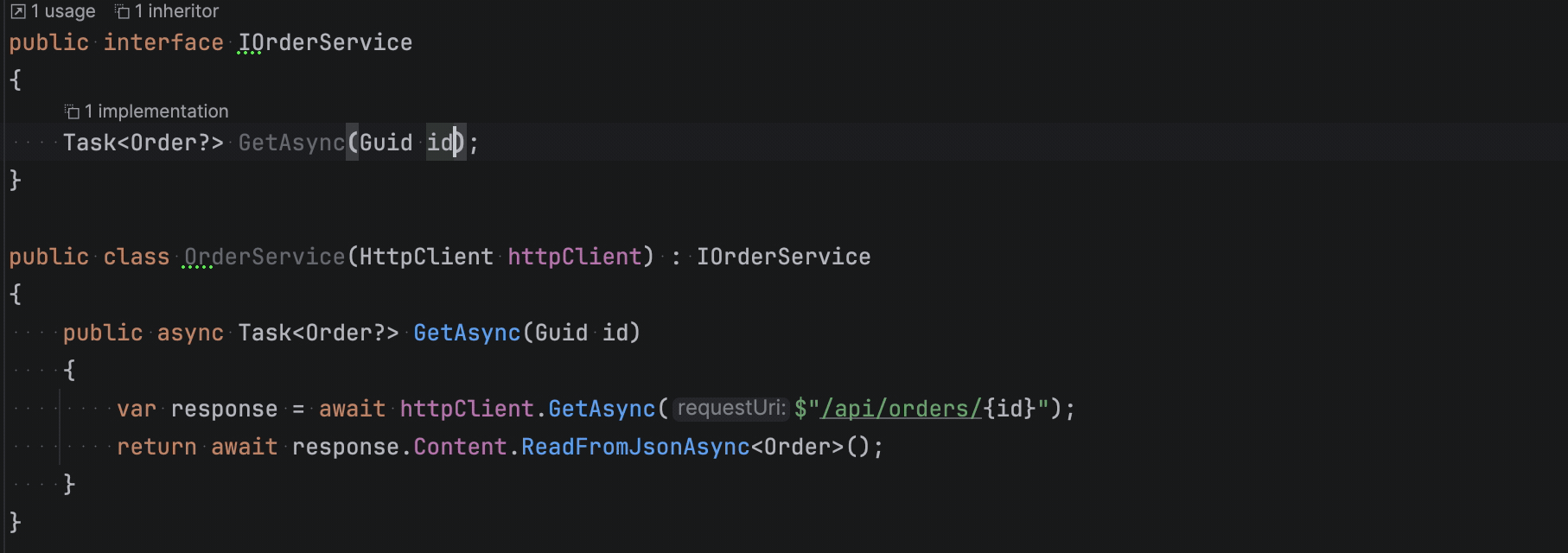
Overall, NES provide a smart code editing experience. Let’s agree to share responsibilities as follows: you can simply type and continue development as you used to, and we suggest small digestible diffs that help you do your job faster. Deal?
Who can use NES?
With the latest AI Assistant update, next edit suggestions are enabled by default for all users with AI Pro, AI Ultimate, or AI Enterprise subscriptions. Unlike AI code completion, the next edit suggestions feature is currently unavailable for AI Free license holders. Stay tuned, though – we are actively working on bringing it to a wider audience!
You can always learn more about which AI features are available in different pricing tiers on our official page.
How do NES work?
Trust us, there is a lot we could say about the internals, but we’ll try to keep things simple here.
Long story short, next edit suggestions are where AI meets 🤝 the intelligence of JetBrains IDEs. Under the hood, the feature calls our cloud-based custom AI model and leverages deterministic IDE actions where possible.
AI model
Currently, at their core, NES rely mostly on suggestions provided by a model fine-tuned specifically for this task.
Much like Mellum, the model is a small language model (SLM) that leverages cloud GPU infrastructure to provide the best possible latency all around the world. Unlike Mellum, however, the underlying model is bigger and leverages a different type of context: the history of your recent changes as opposed to the current file and RAG.
Bigger does not always mean slower! Our inference pipelines differ for code completion and next edit suggestions generation. NES employ several inference tricks that keep latency under 200 ms for the majority of requests, even at the busiest times of the day 💪. If you ever thought that completion in JetBrains IDEs was slow, it’s time to reconsider!
IDE actions (code insights)
Developers love our IDEs because of their reliability, and next edit suggestions put that aspect at your fingertips.
As part of their pipeline, when invoked, NES look for available code insights provided by the IDE and show them in the NES UI if they are appropriate. One of the easiest ways to see this interaction at work would be to look at a suggestion that renames an identifier in a file. The next edit suggestion will activate the IDE’s Rename refactoring, and usages will be conveniently updated. This even works with multi-file search!
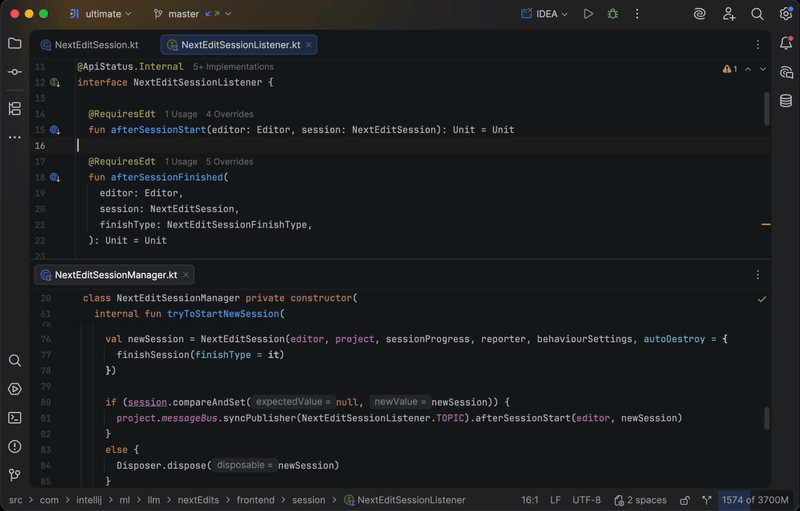
The integration between next edit suggestions and IDE code insights is not yet fully complete. Because even frontier models struggle with out-of-distribution tools, or even just having a large number of tools in general, we are intentionally adding new IDE actions to NES slowly. We are prioritizing the ones that are useful the most often, as well as the ones the models can use most effectively. Let us know in the comments which IDE actions you would find useful in NES!
Summary
Next edit suggestions don’t replace the existing forms of code completion, but complement them, ensuring the best speed and relevance. Where code completion provides suggestions for new material, the next edit suggetions model works in the field of, well, edits. It is optimised to propose changes to existing code, but sometimes the best edit is simply to add something new. In those cases, the suggestions will look like completions because they are presented the same way – as inline gray text.
The simple scheme below explains which suggestion provider can be handled by which UI.
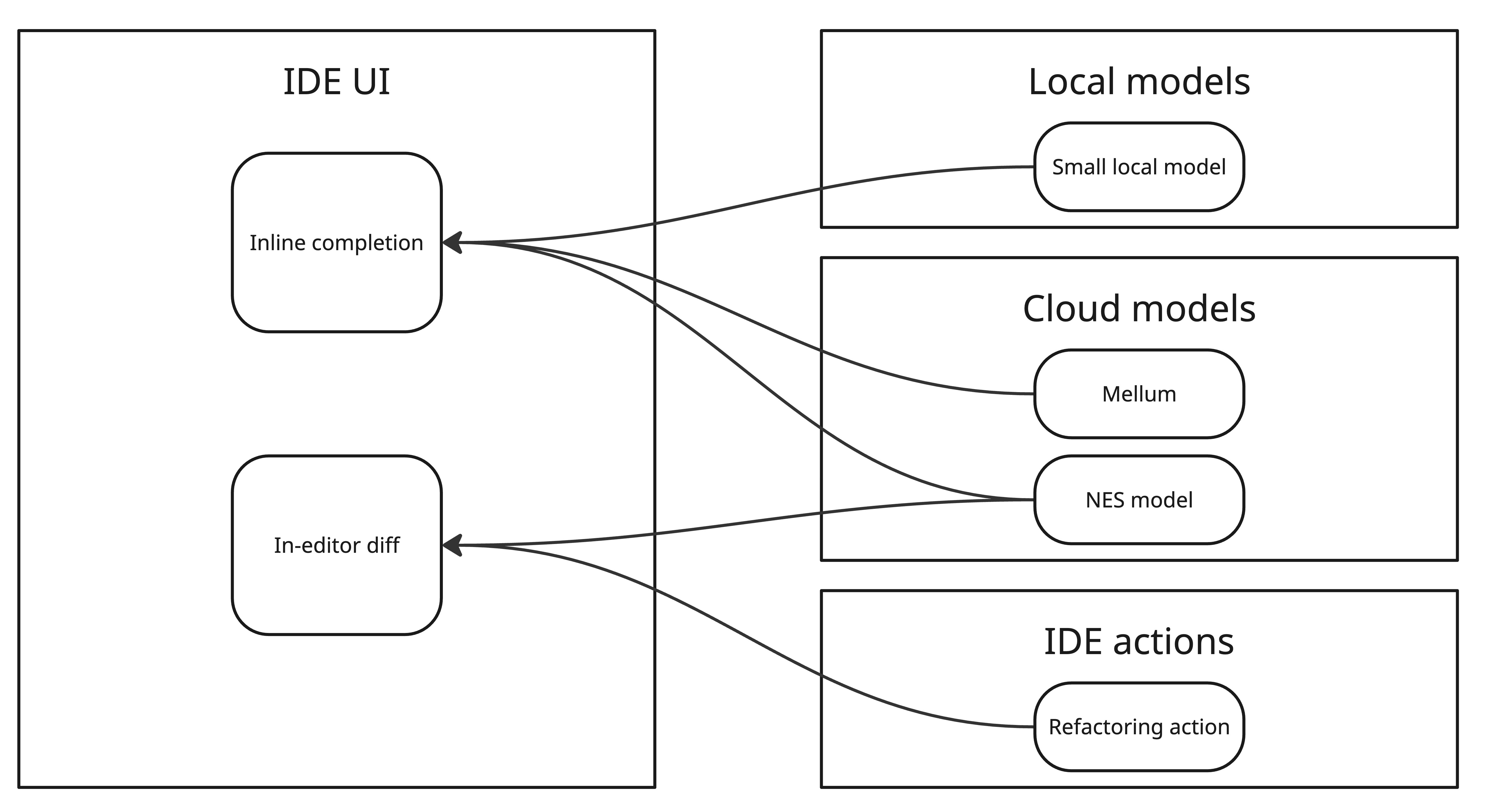
Settings panel update
In addition to enabling this new feature, we are redesigning the settings for AI code completion and next edit suggestions. Shortly after the start of the new year, the settings for these features will be simplified. Instead of having to navigate multiple views, you will be able to view everything on a single screen, with all the most important options available.
Here’s a sneak peek of the new design:

As you can see, the settings for local completion, cloud-based completion, and next edit suggestions are all combined on a single page where you can decide what you want and what you don’t.

AI code completion and NES cheat sheet
Deciding which types of suggestions to enable may feel a bit overwhelming, so we’ve put together a short cheat sheet to help clarify which settings to enable in the new settings panel, depending on your preferred workflow.
Case 1: You don’t want AI in your editor
Simply turn off inline completion and next edit suggestions on this panel. We’ll make sure you don’t see any results of matrix multiplications.
Case 2: You don’t want cloud-based suggestions
Just turn on inline completion with local models. Those models are already bundled into your IDE and work without an internet connection. Good ol’ full line code completion will have your back.
If you want your own local solution, you can plug any open-source model into the IDE via LM Studio or Ollama. This option is available on the AI Assistant | Models settings page. Note that, currently, this option only works for code completion. We will closely monitor the level of quality that is possible with local inference for NES, with the aim of eventually including it as well.
Case 3: You like completion but NES seem off
In this case, the best solution is to turn on inline completion with the Cloud and local models option and make sure that next edit suggestions are turned off. You will get the best from the Mellum model, and the IDE will automatically fall back to local models if your internet connection is unstable.
Case 4: You like full-blown in-editor AI assistance
Turn on both cloud models for inline completion and next edit suggestions to get code snippet suggestions as you modify your source code.
What’s next for NES?
Here is a quick look at some of the improvements we’re already working on:
- Smarter and more precise suggestions
- More IDE actions for NES to use
- Longer tab sequences
Many other developments are on our radar, and we’ll keep you updated as they come closer to fruition.
Thank-you note
While you update your AI Assistant and GPUs go brrr, we would like to thank everyone who participated in the open Beta test for the next edit suggestions feature this fall.
Over the last few months, the feature has been available to JetBrains AI subscribers who were willing to try it and share anonymous usage statistics. With your help, we were able to make sure the feature was ready and properly prepare the cloud infrastructure for a full-scale release. Thank you so much! ❤️
Tab–Tab,
Your AI completion team
Real Python
Learn From 2025's Most Popular Python Tutorials and Courses
As we welcome 2026, it’s time to look back on an exciting year for Python. Python 3.14 arrived with a wave of developer-focused improvements, from lazy annotations that finally resolve long-standing type hinting quirks to clever new t-strings that give you more control over string interpolation.
Meanwhile, 2025 was the year AI tools truly became part of everyday Python development. From agentic coding with LangGraph to connecting LLMs to your data via MCP servers, Python solidified its position as the language of choice for AI-powered workflows.
Here at Real Python, we’re excited to showcase the tutorials and video courses that resonated most with our community throughout 2025. Whether you’re just starting out with Python, leveling up your skills, or diving into advanced topics, this collection has something for you.
Join Now: Click here to join the Real Python Newsletter and you’ll never miss another Python tutorial, course, or news update.
Take the Quiz: Test your knowledge with our interactive “Python Skill Test” quiz. You’ll receive a score upon completion to help you track your learning progress:
Interactive Quiz
Python Skill TestTest your Python knowledge in a skills quiz with basic to advanced questions. Are you a Novice, Intermediate, Proficient, or Expert?
Strengthen Your Python Foundations

If you’re just getting started with Python, building a solid foundation is the best investment you can make. The fundamentals you learn now will support everything you do later, from data analysis to web development to AI.
These beginner-friendly tutorials and courses help you sharpen the core skills you’ll use every day in Python, including loops, operators, lists, and functional techniques:
- How to Join Strings in Python
- Skip Ahead in Loops With Python’s continue Keyword
- Nested Loops in Python
- Python Operators and Expressions
- Exploring Python’s list Data Type With Examples
- Using Functional Programming in Python
If you’re looking to accelerate your learning with live instruction, then check out our Python for Beginners Live Course, where you can learn alongside other students and get real-time feedback from experienced instructors.
And don’t forget to grab our downloadable Python 3 Cheat Sheet to keep essential syntax and concepts at your fingertips:
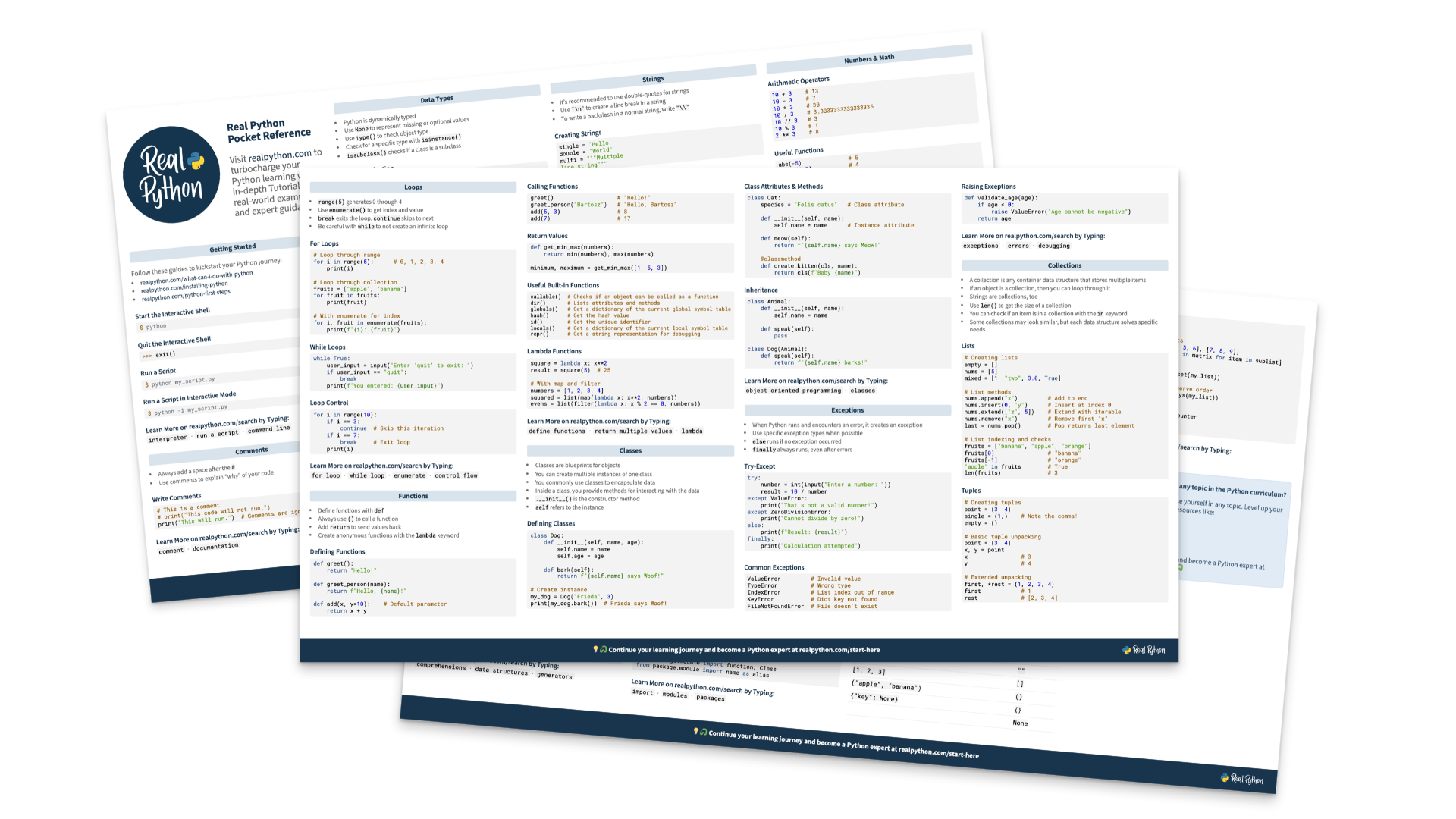
Explore What’s New in Python 3.14
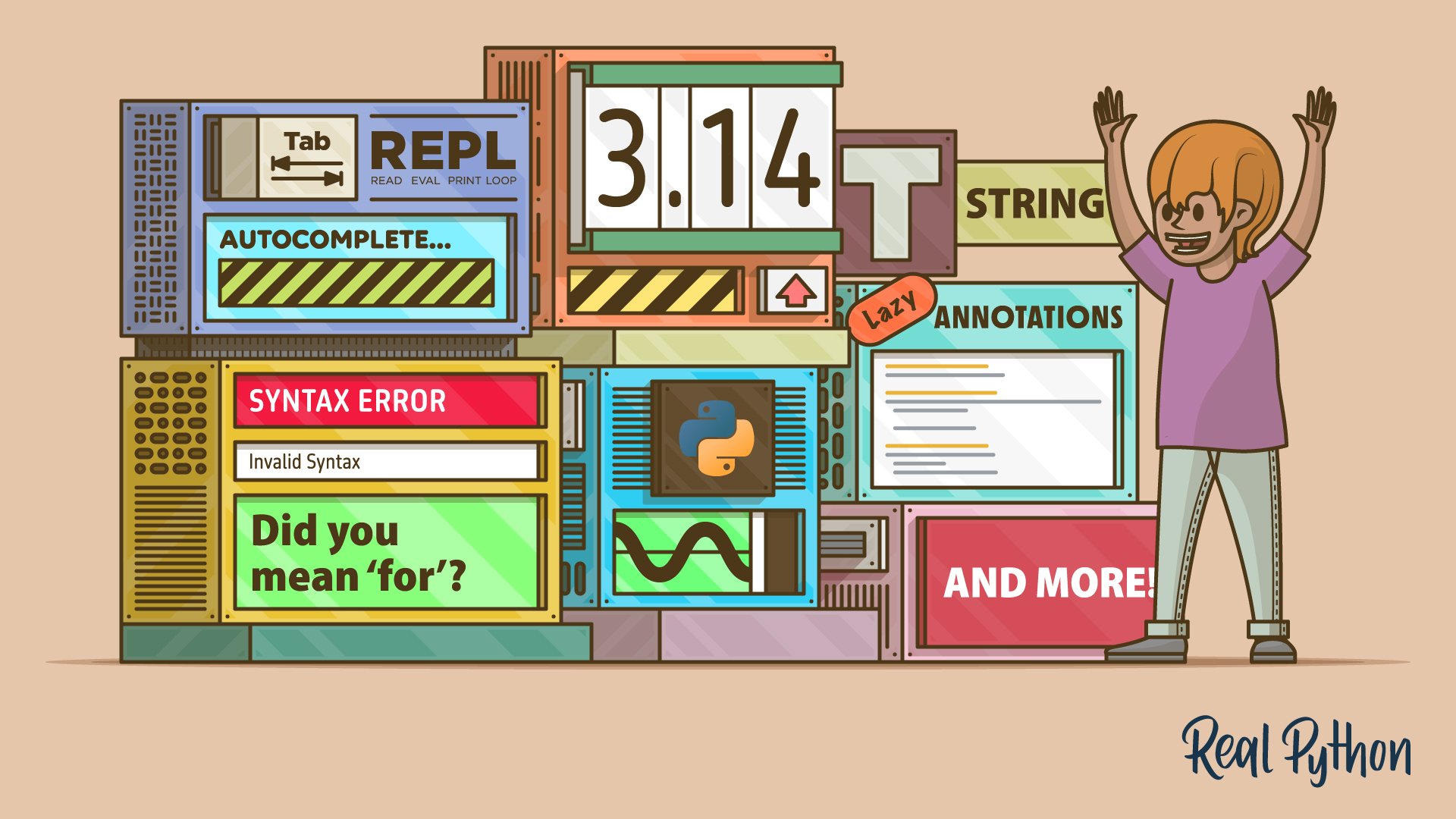
Python 3.14 brought a collection of thoughtful improvements that make writing and debugging code more enjoyable. The REPL now feels like a proper modern shell, making third-party REPLs like IPython, ptpython, and bpython less necessary. Type hints behave more intuitively, error messages point you in the right direction faster, and t-strings open up new possibilities for string processing.
These tutorials walk you through the updates you’ll want to start using right away:
- Python 3.14: Cool New Features for You to Try
- Python 3.14: Lazy Annotations
- Python 3.14: REPL Autocompletion and Highlighting
- Python 3.14: Better Syntax Error Messages
- Python 3.14: Template Strings (T-Strings)
If you’re curious about any other new features, you can also read the 3.14 release notes. Staying current with new Python releases helps you write cleaner code and take advantage of performance improvements as they land.
Read the full article at https://realpython.com/popular-python-tutorials-2025/ »
[ Improve Your Python With 🐍 Python Tricks 💌 – Get a short & sweet Python Trick delivered to your inbox every couple of days. >> Click here to learn more and see examples ]
Quiz: How to Convert Bytes to Strings in Python
In this quiz, you’ll test your understanding of the Convert Python Bytes to Strings tutorial.
By working through this quiz, you’ll revisit how to decode bytes, choose an encoding, and turn binary data into readable text.
You’ll also see how encodings map byte values to characters so you can handle data from files, databases, and APIs with confidence. For a deeper dive, check out Python Encodings: A Guide and Python Bytes.
[ Improve Your Python With 🐍 Python Tricks 💌 – Get a short & sweet Python Trick delivered to your inbox every couple of days. >> Click here to learn more and see examples ]
Quiz: How to Properly Indent Python Code
In this quiz, you’ll test your understanding of How to Indent in Python.
By working through this quiz, you’ll revisit how to properly indent Python code, choose helpful editor settings, use spaces properly, apply code formatters, and explain why indentation is required.
[ Improve Your Python With 🐍 Python Tricks 💌 – Get a short & sweet Python Trick delivered to your inbox every couple of days. >> Click here to learn more and see examples ]
Patrick Müller
Static Protocols in Python: Behaviour Over Inheritance
The first time I read about protocols was in the book "Fluent Python" by Luciano Ramalho. This book goes deep. Deeper than I knew Python at that time. If you hadn&apost heard of Protocols before, I&aposll give you a short introduction.
Protocols have something to do with typing. With protocols, you can check whether an object is valid based on whether it has the right methods and attributes. The idea is to check for behaviour instead of inheritance. Protocols extend Python&aposs type hints by allowing to define structural types. They can be very confusing at first and difficult to understand, especially in a real-world scenario. In my opinion, that&aposs partly because, for the concept to click, one must mentally move away from pure object-oriented programming. This is mostly done with inheritance. But it&aposs also difficult to understand, because I think it&aposs an advanced concept. Typing is also a gradually evolving topic in Python, with a naming scheme that has also evolved gradually and which is sometimes difficult to grasp, too.
Generally, we distinguish between dynamic and static protocols. This article is about static protocols.
What&aposs mostly used - Goose Typing
It&aposs best to start with a short example. Before I knew protocols, I had used isinstance to check for a type. This is also called goose typing. Mostly this is used when one wants to check if an object is of a specific type during runtime. During runtime is important here. Here&aposs an example:
def fly_to_moon(something):
if isinstance(something, Spaceship)
spaceship.fly()
else:
print("Ain&apost flying to the moon with this")Usually, goose typing is used with ABCs and abstract classes. The concept aligns very well with the human brain. With inheritance, we can bring structure to chaos. It&aposs neat. Most of the time, developers think about the domain they develop functions for, and then come up with an inheritance tree that&aposs very carefully crafted for that domain. In the scenario above, we&aposd have a base class of Plane and a class Spaceship that inherits from Plane. It inherits a fly method along. What I do not like about this is that, in application software, I do not want to limit the possibilities upfront by using inheritance. Secondly, with inheritance, we introduce tight coupling, which is a drawback.
Static Protocols
Protocols come with the idea that an object should behave in a certain way (structural typing), rather than implementing a certain interface or inheriting from a base class, which is also called nominal typing.
Short Intro

Structural means we care about the behaviour. So, as long as we have an object that supports a fly function, we are pretty happy with it and think, "Okay, you apparently have all you need, let&aposs go". Here&aposs how we would adjust our example from above to use protocols:
from typing import Protocol
class MoonFlyable(Protocol):
def fly(self): …
class Superman:
def fly(self):
print(&aposI am not a plane but still able to fly to the moon 🚀&apos)
def fly_to_moon(who_knows: MoonFlyable):
who_knows.fly()Now, our construct is not only cleaner than goose typing and reduces coupling, but also enables static type checkers like MyPy, PyRight, or ty to pick up on compatibility before we run the code.
While you can write fly_to_moon(new Superman()) , a static type checker will complain about fly_to_moon(new Car())
Remember, all we ask for is a specific behaviour to be fulfilled. This gives us greater flexibility in our software design. Here&aposs my take on illustrating this:
 Superman is able to fly to the moon ...
Superman is able to fly to the moon ...That example is a bit artificial, but serves perfectly as a short intro.
Real-World Example
Real world code is mostly more complex than this, and when I read tutorials, I most often wish to see something a bit more difficult.
As a software engineer in the AI field, I sometimes need load different trained models for certain projects. A very basic machine learning use case is to predict a class, and we have different models that predict different classes (e.g. cats or dogs, not Python classes) in different ways. You often see ABC here, but, as I said before, I think you lose flexibility this way. With protocols, each developer on the team can create, train and predict without extending an inheritance tree. I prefer to program functionally as I favour composition over inheritance, but others can code object-oriented and the code remains compatible.
Here&aposs how this looks like:
from typing import Protocol
class Predictable(Protocol):
"""Protocol for models that can make predictions (Used for API)."""
def predict_top_k(self, query: str, k: int) -> list[str]:
...
class TfidfPredictor:
"""Predictor class for TF-IDF model to get top-k predictions."""
def __init__(self, model):
self.model = model
def predict_top_k(self, query: str, k: int) -> list[str]:
"""Predict top-k classes and their probabilities."""
# code ommitted because not relevant here
tfidf_model = load_model(model_path)
ml_models: dict[str, Predictable] = {}
ml_models[&apostfidf&apos] = TfidfPredictor(tfidf_model)The TfidfPredictor is really just a wrapper that contains only the predict_top_k function the protocol wants to see. This demonstrates how I would store loaded models in a dictionary, using the Predictable protocol as the value type. We can then run the predictions in a &aposduck typing&apos manner based on this.
Alternatively, we could use the protocol class for our inference method.
tfidf_model = load_model(model_path)
predictor = TfidfPredictor(tfidf_model)
def run_inference(model: Predictable, query: str, k: int) -> list[str]:
return model.predict_top_k(query, k)
y_pred_k = run_inference(model=predictor, query="Classify this text", k=5)Now, if you look at the code, you see that the TfidfPredictor is completely independent of implementing any ABC. All we care about is that the model we pass to our dictionary or to the run_inference function is compliant with the Predictable protocol.
Limitations of Static Protocols
Keep in mind that protocols do not guarantee that, at runtime, the type is enforced. If you need to check during runtime, you would need to decorate your defined protocol with @runtime_checkable. Then, you could use isinstance again: isinstance(obj, Predictable).
Small Detour to Duck Typing and Static vs. Dynamic Protocols
When I say duck typing, it has to come with the very famous saying: "If it walks like a duck and it quacks like a duck, then it must be a duck.". This saying provides you the interpreter&aposs view on an object. As long as an object provides the required behaviour (e.g. the quack() method), it will be used as a duck, regardless of its actual type. This should sound familiar to you from static protocols. Both are behavioural. The main difference is that your IDE or a static type checker won&apost give you any hint about the correctness of the signature. Here&aposs an adapted example from the Duck Typing article on Real Python:
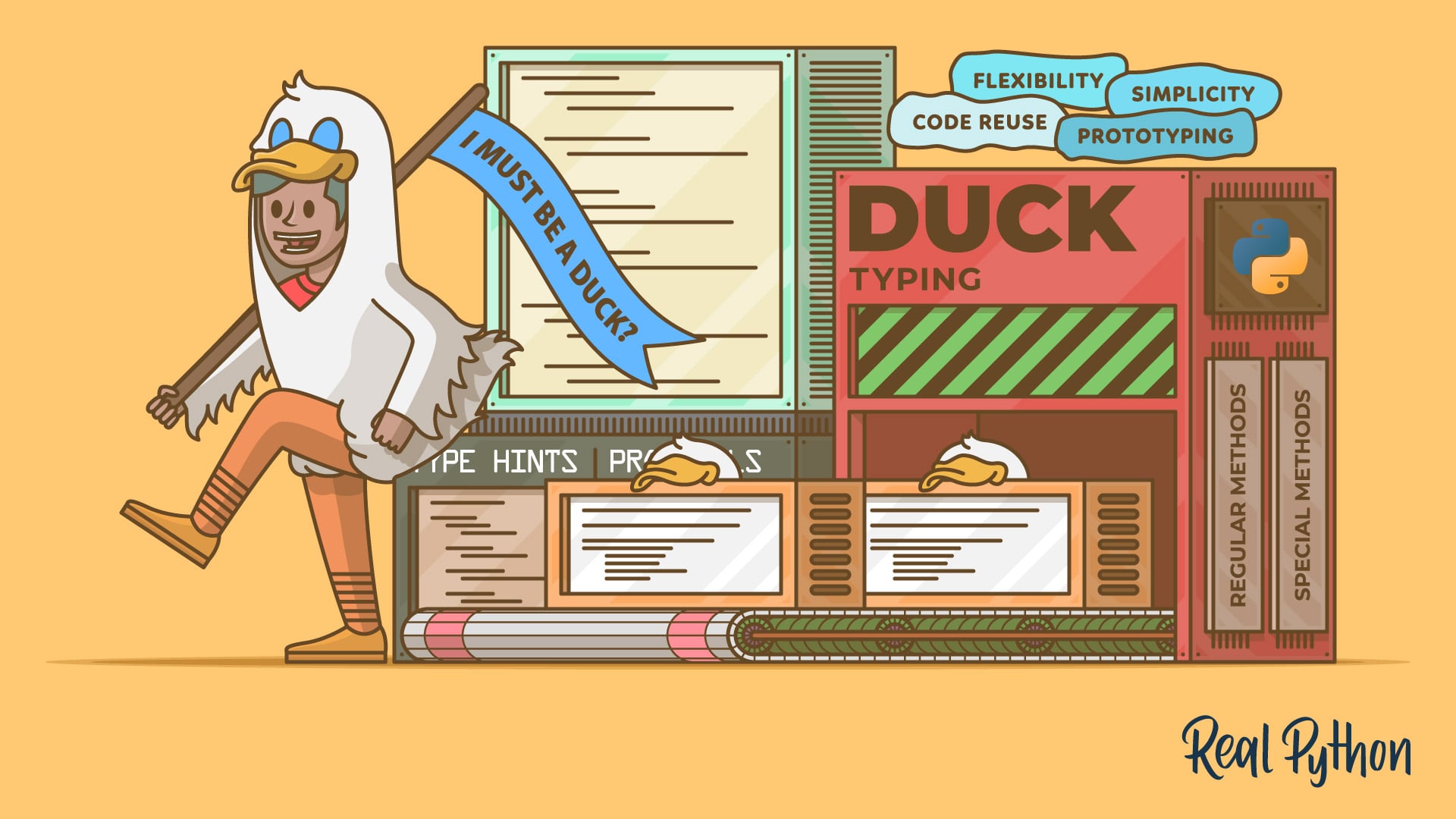
class Duck:
def fly(self):
print("The duck is flying")
class Swan:
def fly(self, height: int):
print("The swan is flying")
birds = [Duck(), Swan()]
for bird in birds:
bird.fly()In this example, my static type checker (Pyright) doesn&apost tell me that we need a height for the Swan object to run the fly method. Duck typing is used with EAFP, and I like it. Static protocols extend the idea and make it safer to program, catching possible runtime errors during development time and not runtime. Small side note: Structural (sub)typing is also called static duck typing.
Conclusion
This article was about static protocols, also called static duck typing. It&aposs baked in Python since version 3.8. Before that, we&aposd had already informal interfaces, also called dynamic protocols. The naming is sometimes confusing, and I have to look it up from time to time myself.
The difference is that a dynamic protocol does not have to be fully implemented and it cannot be verified by a static type checker. An example of a dynamic protocol is the Sequence protocol, which requires the __getitem__ and the __len__ ; however, it also works only with __getitem__.
To me, the main advantage of static protocols is the ability to write loose coupling code, not to run in an increasingly complex construct of inheritance, and, most importantly, to provide a way to specify a specific behaviour (structural types) instead of nominal types. Hence, in a project, it becomes easier to bring different developer styles and libraries together. One might write more functional code, another more object oriented. Besides that, it&aposs cumbersome to make different libraries (machine learning world) work with each other in own pipelines.
If you want to read more about static protocols, I can recommend the original PEP 544 – Protocols: Structural subtyping (static duck typing) .
This was a short primer on using static protocols in a real-world project. Ever run into issues with ABCs (too big to touch, too complex?!)? Let me know!
Talk Python to Me
#533: Web Frameworks in Prod by Their Creators
Today on Talk Python, the creators behind FastAPI, Flask, Django, Quart, and Litestar get practical about running apps based on their framework in production. Deployment patterns, async gotchas, servers, scaling, and the stuff you only learn at 2 a.m. when the pager goes off. For Django, we have Carlton Gibson and Jeff Triplet. For Flask, we have David Lord and Phil Jones, and on team Litestar we have Janek Nouvertné and Cody Fincher, and finally Sebastián Ramírez from FastAPI is here. Let’s jump in.<br/> <br/> <strong>Episode sponsors</strong><br/> <br/> <a href='https://talkpython.fm/training'>Talk Python Courses</a><br> <a href='https://talkpython.fm/devopsbook'>Python in Production</a><br/> <br/> <h2 class="links-heading mb-4">Links from the show</h2> <div><strong>Carlton Gibson - Django</strong>: <a href="https://github.com/carltongibson?featured_on=talkpython" target="_blank" >github.com</a><br/> <strong>Sebastian Ramirez - FastAPI</strong>: <a href="https://github.com/tiangolo?featured_on=talkpython" target="_blank" >github.com</a><br/> <strong>David Lord - Flask</strong>: <a href="https://davidism.com?featured_on=talkpython" target="_blank" >davidism.com</a><br/> <strong>Phil Jones - Flask and Quartz(async)</strong>: <a href="https://pgjones.dev?featured_on=talkpython" target="_blank" >pgjones.dev</a><br/> <strong>Yanik Nouvertne - LiteStar</strong>: <a href="https://github.com/provinzkraut?featured_on=talkpython" target="_blank" >github.com</a><br/> <strong>Cody Fincher - LiteStar</strong>: <a href="https://github.com/cofin?featured_on=talkpython" target="_blank" >github.com</a><br/> <strong>Jeff Triplett - Django</strong>: <a href="https://jefftriplett.com?featured_on=talkpython" target="_blank" >jefftriplett.com</a><br/> <br/> <strong>Django</strong>: <a href="https://www.djangoproject.com?featured_on=talkpython" target="_blank" >www.djangoproject.com</a><br/> <strong>Flask</strong>: <a href="https://flask.palletsprojects.com/en/latest/?featured_on=talkpython" target="_blank" >flask.palletsprojects.com</a><br/> <strong>Quart</strong>: <a href="https://quart.palletsprojects.com/en/latest/?featured_on=talkpython" target="_blank" >quart.palletsprojects.com</a><br/> <strong>Litestar</strong>: <a href="https://litestar.dev?featured_on=talkpython" target="_blank" >litestar.dev</a><br/> <strong>FastAPI</strong>: <a href="https://fastapi.tiangolo.com?featured_on=talkpython" target="_blank" >fastapi.tiangolo.com</a><br/> <strong>Coolify</strong>: <a href="https://coolify.io?featured_on=talkpython" target="_blank" >coolify.io</a><br/> <strong>ASGI</strong>: <a href="https://asgi.readthedocs.io/en/latest/?featured_on=talkpython" target="_blank" >asgi.readthedocs.io</a><br/> <strong>WSGI (PEP 3333)</strong>: <a href="https://peps.python.org/pep-3333/?featured_on=talkpython" target="_blank" >peps.python.org</a><br/> <strong>Granian</strong>: <a href="https://github.com/emmett-framework/granian?featured_on=talkpython" target="_blank" >github.com</a><br/> <strong>Hypercorn</strong>: <a href="https://github.com/pgjones/hypercorn?featured_on=talkpython" target="_blank" >github.com</a><br/> <strong>uvicorn</strong>: <a href="https://uvicorn.dev?featured_on=talkpython" target="_blank" >uvicorn.dev</a><br/> <strong>Gunicorn</strong>: <a href="https://gunicorn.org/?featured_on=talkpython" target="_blank" >gunicorn.org</a><br/> <strong>Hypercorn</strong>: <a href="https://hypercorn.readthedocs.io/en/latest/?featured_on=talkpython" target="_blank" >hypercorn.readthedocs.io</a><br/> <strong>Daphne</strong>: <a href="https://github.com/django/daphne?featured_on=talkpython" target="_blank" >github.com</a><br/> <strong>Nginx</strong>: <a href="https://nginx.org/?featured_on=talkpython" target="_blank" >nginx.org</a><br/> <strong>Docker</strong>: <a href="https://www.docker.com/?featured_on=talkpython" target="_blank" >www.docker.com</a><br/> <strong>Kubernetes</strong>: <a href="https://kubernetes.io/?featured_on=talkpython" target="_blank" >kubernetes.io</a><br/> <strong>PostgreSQL</strong>: <a href="https://www.postgresql.org/?featured_on=talkpython" target="_blank" >www.postgresql.org</a><br/> <strong>SQLite</strong>: <a href="https://www.sqlite.org/?featured_on=talkpython" target="_blank" >www.sqlite.org</a><br/> <strong>Celery</strong>: <a href="https://docs.celeryq.dev/?featured_on=talkpython" target="_blank" >docs.celeryq.dev</a><br/> <strong>SQLAlchemy</strong>: <a href="https://www.sqlalchemy.org/?featured_on=talkpython" target="_blank" >www.sqlalchemy.org</a><br/> <strong>Django REST framework</strong>: <a href="https://www.django-rest-framework.org/?featured_on=talkpython" target="_blank" >www.django-rest-framework.org</a><br/> <strong>Jinja</strong>: <a href="https://jinja.palletsprojects.com/?featured_on=talkpython" target="_blank" >jinja.palletsprojects.com</a><br/> <strong>Click</strong>: <a href="https://click.palletsprojects.com/?featured_on=talkpython" target="_blank" >click.palletsprojects.com</a><br/> <strong>HTMX</strong>: <a href="https://htmx.org/?featured_on=talkpython" target="_blank" >htmx.org</a><br/> <strong>Server-Sent Events (SSE)</strong>: <a href="https://developer.mozilla.org/en-US/docs/Web/API/Server-sent_events?featured_on=talkpython" target="_blank" >developer.mozilla.org</a><br/> <strong>WebSockets (RFC 6455)</strong>: <a href="https://www.rfc-editor.org/rfc/rfc6455?featured_on=talkpython" target="_blank" >www.rfc-editor.org</a><br/> <strong>HTTP/2 (RFC 9113)</strong>: <a href="https://www.rfc-editor.org/rfc/rfc9113?featured_on=talkpython" target="_blank" >www.rfc-editor.org</a><br/> <strong>HTTP/3 (RFC 9114)</strong>: <a href="https://www.rfc-editor.org/rfc/rfc9114?featured_on=talkpython" target="_blank" >www.rfc-editor.org</a><br/> <strong>uv</strong>: <a href="https://docs.astral.sh/uv/?featured_on=talkpython" target="_blank" >docs.astral.sh</a><br/> <strong>Amazon Web Services (AWS)</strong>: <a href="https://aws.amazon.com/?featured_on=talkpython" target="_blank" >aws.amazon.com</a><br/> <strong>Microsoft Azure</strong>: <a href="https://azure.microsoft.com/?featured_on=talkpython" target="_blank" >azure.microsoft.com</a><br/> <strong>Google Cloud Run</strong>: <a href="https://cloud.google.com/run?featured_on=talkpython" target="_blank" >cloud.google.com</a><br/> <strong>Amazon ECS</strong>: <a href="https://aws.amazon.com/ecs/?featured_on=talkpython" target="_blank" >aws.amazon.com</a><br/> <strong>AlloyDB for PostgreSQL</strong>: <a href="https://cloud.google.com/alloydb?featured_on=talkpython" target="_blank" >cloud.google.com</a><br/> <strong>Fly.io</strong>: <a href="https://fly.io/?featured_on=talkpython" target="_blank" >fly.io</a><br/> <strong>Render</strong>: <a href="https://render.com/?featured_on=talkpython" target="_blank" >render.com</a><br/> <strong>Cloudflare</strong>: <a href="https://www.cloudflare.com/?featured_on=talkpython" target="_blank" >www.cloudflare.com</a><br/> <strong>Fastly</strong>: <a href="https://www.fastly.com/?featured_on=talkpython" target="_blank" >www.fastly.com</a><br/> <br/> <strong>Watch this episode on YouTube</strong>: <a href="https://www.youtube.com/watch?v=cHmoClKu6qk" target="_blank" >youtube.com</a><br/> <strong>Episode #533 deep-dive</strong>: <a href="https://talkpython.fm/episodes/show/533/web-frameworks-in-prod-by-their-creators#takeaways-anchor" target="_blank" >talkpython.fm/533</a><br/> <strong>Episode transcripts</strong>: <a href="https://talkpython.fm/episodes/transcript/533/web-frameworks-in-prod-by-their-creators" target="_blank" >talkpython.fm</a><br/> <br/> <strong>Theme Song: Developer Rap</strong><br/> <strong>🥁 Served in a Flask 🎸</strong>: <a href="https://talkpython.fm/flasksong" target="_blank" >talkpython.fm/flasksong</a><br/> <br/> <strong>---== Don't be a stranger ==---</strong><br/> <strong>YouTube</strong>: <a href="https://talkpython.fm/youtube" target="_blank" ><i class="fa-brands fa-youtube"></i> youtube.com/@talkpython</a><br/> <br/> <strong>Bluesky</strong>: <a href="https://bsky.app/profile/talkpython.fm" target="_blank" >@talkpython.fm</a><br/> <strong>Mastodon</strong>: <a href="https://fosstodon.org/web/@talkpython" target="_blank" ><i class="fa-brands fa-mastodon"></i> @talkpython@fosstodon.org</a><br/> <strong>X.com</strong>: <a href="https://x.com/talkpython" target="_blank" ><i class="fa-brands fa-twitter"></i> @talkpython</a><br/> <br/> <strong>Michael on Bluesky</strong>: <a href="https://bsky.app/profile/mkennedy.codes?featured_on=talkpython" target="_blank" >@mkennedy.codes</a><br/> <strong>Michael on Mastodon</strong>: <a href="https://fosstodon.org/web/@mkennedy" target="_blank" ><i class="fa-brands fa-mastodon"></i> @mkennedy@fosstodon.org</a><br/> <strong>Michael on X.com</strong>: <a href="https://x.com/mkennedy?featured_on=talkpython" target="_blank" ><i class="fa-brands fa-twitter"></i> @mkennedy</a><br/></div>
Python Bytes
#464 Malicious Package? No Build For You!
<strong>Topics covered in this episode:</strong><br> <ul> <li><strong><a href="https://astral.sh/blog/ty?featured_on=pythonbytes">ty: An extremely fast Python type checker and LSP</a></strong></li> <li><strong><a href="https://mkennedy.codes/posts/python-supply-chain-security-made-easy/?featured_on=pythonbytes">Python Supply Chain Security Made Easy</a></strong></li> <li><strong><a href="https://typing-extensions.readthedocs.io/en/latest/?featured_on=pythonbytes">typing_extensions</a></strong></li> <li><strong><a href="https://www.theregister.com/2025/12/16/mi6_chief_well_be_as/?featured_on=pythonbytes">MI6 chief: We'll be as fluent in Python as we are in Russian</a></strong></li> <li><strong>Extras</strong></li> <li><strong>Joke</strong></li> </ul><a href='https://www.youtube.com/watch?v=ZUFz1WkCZCg' style='font-weight: bold;'data-umami-event="Livestream-Past" data-umami-event-episode="464">Watch on YouTube</a><br> <p><strong>About the show</strong></p> <p><strong>Connect with the hosts</strong></p> <ul> <li>Michael: <a href="https://fosstodon.org/@mkennedy">@mkennedy@fosstodon.org</a> / <a href="https://bsky.app/profile/mkennedy.codes?featured_on=pythonbytes">@mkennedy.codes</a> (bsky)</li> <li>Brian: <a href="https://fosstodon.org/@brianokken">@brianokken@fosstodon.org</a> / <a href="https://bsky.app/profile/brianokken.bsky.social?featured_on=pythonbytes">@brianokken.bsky.social</a></li> <li>Show: <a href="https://fosstodon.org/@pythonbytes">@pythonbytes@fosstodon.org</a> / <a href="https://bsky.app/profile/pythonbytes.fm">@pythonbytes.fm</a> (bsky)</li> </ul> <p>Join us on YouTube at <a href="https://pythonbytes.fm/stream/live"><strong>pythonbytes.fm/live</strong></a> to be part of the audience. Usually <strong>Monday</strong> at 10am PT. Older video versions available there too.</p> <p>Finally, if you want an artisanal, hand-crafted digest of every week of the show notes in email form? Add your name and email to <a href="https://pythonbytes.fm/friends-of-the-show">our friends of the show list</a>, we'll never share it.</p> <p><strong>Brian #1: <a href="https://astral.sh/blog/ty?featured_on=pythonbytes">ty: An extremely fast Python type checker and LSP</a></strong></p> <ul> <li>Charlie Marsh announced the Beta release of <code>ty</code> on Dec 16</li> <li>“designed as an alternative to tools like mypy, Pyright, and Pylance.”</li> <li>Extremely fast even from first run</li> <li>Successive runs are incremental, only rerunning necessary computations as a user edits a file or function. This allows live updates.</li> <li>Includes nice visual diagnostics much like color enhanced tracebacks</li> <li>Extensive configuration control <ul> <li>Nice for if you want to gradually fix warnings from ty for a project</li> </ul></li> <li>Also released a nice <a href="https://marketplace.visualstudio.com/items?itemName=astral-sh.ty&featured_on=pythonbytes">VSCode (or Cursor) extension</a> <ul> <li>Check the docs. There are lots of features.</li> <li>Also a note about disabling the default language server (or disabling ty’s language server) so you don’t have 2 running</li> </ul></li> </ul> <p><strong>Michael #2:</strong> <a href="https://mkennedy.codes/posts/python-supply-chain-security-made-easy/?featured_on=pythonbytes">Python Supply Chain Security Made Easy</a></p> <ul> <li>We know about supply chain security issues, but what can you do? <ul> <li>Typosquatting (not great)</li> <li>Github/PyPI account take-overs (very bad)</li> </ul></li> <li>Enter <a href="https://github.com/pypa/pip-audit?featured_on=pythonbytes">pip-audit</a>.</li> <li>Run it in two ways: <ol> <li>Against your installed dependencies in current venv</li> <li>As a proper unit test (so when running pytest or CI/CD).</li> <li>Let others find out first, wait a week on all dependency updates: <code>uv pip compile requirements.piptools --upgrade --output-file requirements.txt --exclude-newer "1 week"</code></li> </ol></li> <li>Follow up article: <a href="https://mkennedy.codes/posts/devops-python-supply-chain-security/?featured_on=pythonbytes">DevOps Python Supply Chain Security</a> <ol> <li>Create a dedicated Docker image for testing dependencies with pip-audit in isolation before installing them into your venv. <ol> <li>Run pip-compile / uv lock --upgrade to generate the new lock file</li> <li>Test in a ephemeral pip-audit optimized Docker container</li> <li>Only then if things pass, uv pip install / uv sync</li> </ol></li> <li>Add a dedicated Docker image build step that fails the <code>docker build</code> step if a vulnerable package is found.</li> </ol></li> </ul> <p><strong>Brian #3: <a href="https://typing-extensions.readthedocs.io/en/latest/?featured_on=pythonbytes">typing_extensions</a></strong></p> <ul> <li>Kind of a followup on the deprecation warning topic we were talking about in December.</li> <li><a href="https://hachyderm.io/@prioinv/115767086197017938?featured_on=pythonbytes">prioinv</a> on Mastodon notified us that the project <a href="https://typing-extensions.readthedocs.io/en/latest/#typing_extensions.deprecated">typing-extensions</a> includes it as part of the backport set.</li> <li>The warnings.deprecated decorator is new to Python 3.13, but with <code>typing-extensions</code>, you can use it in previous versions.</li> <li>But <code>typing_extesions</code> is way cooler than just that.</li> <li>The module serves 2 purposes: <ul> <li>Enable use of new type system features on older Python versions.</li> <li>Enable experimentation with type system features proposed in new PEPs before they are accepted and added to the <a href="https://docs.python.org/3.14/library/typing.html#module-typing"><strong><code>typing</code></strong></a> module.</li> </ul></li> <li>So cool.</li> <li>There’s a lot of features here. I’m hoping it allows someone to use the latest typing syntax across multiple Python versions.</li> <li>I’m “tentatively” excited. But I’m bracing for someone to tell me why it’s not a silver bullet.</li> </ul> <p><strong>Michael #4:</strong> <a href="https://www.theregister.com/2025/12/16/mi6_chief_well_be_as/?featured_on=pythonbytes">MI6 chief: We'll be as fluent in Python as we are in Russian</a></p> <ul> <li>"Advances in artificial intelligence, biotechnology and quantum computing are not only revolutionizing economies but rewriting the reality of conflict, as they 'converge' to create science fiction-like tools,” said new MI6 chief Blaise Metreweli.</li> <li>She focused mainly on threats from Russia, the country is "testing us in the grey zone with tactics that are just below the threshold of war.”</li> <li>This demands what she called "mastery of technology" across the service, with officers required to become "as comfortable with lines of code as we are with human sources, as fluent in Python as we are in multiple other languages."</li> <li>Recruitment will target linguists, data scientists, engineers, and technologists alike.</li> </ul> <p><strong>Extras</strong></p> <p>Brian:</p> <ul> <li>Next chapter of Lean TDD being released today, Finding Waste in TDD <ul> <li>Still going to attempt a Jan 31 deadline for first draft of book.</li> <li>That really doesn’t seem like enough time, but I’m optimistic.</li> </ul></li> <li><a href="https://www.steamdeck.com/en/?featured_on=pythonbytes">SteamDeck</a> is not helping me find time to write <ul> <li>But I very much appreciate the gift from my fam</li> <li>Send me game suggestions on Mastodon or Bluesky. I’d love to hear what you all are playing.</li> </ul></li> </ul> <p>Michael:</p> <ul> <li>Astral has announced the Beta release of ty, which they say they are "ready to recommend to motivated users for production use." <ul> <li><a href="https://astral.sh/blog/ty?featured_on=pythonbytes">Blog post</a></li> <li><a href="https://github.com/astral-sh/ty/releases/tag/0.0.2?featured_on=pythonbytes">Release page</a></li> </ul></li> <li>Reuven Lerner has <a href="https://www.youtube.com/watch?v=TCSjgvtO714&list=PLbFHh-ZjYFwFWHVT0qeg9Jz1TBD0TlJJT">a video series on Pandas 3</a></li> </ul> <p><strong>Joke:</strong> <a href="https://x.com/pr0grammerhum0r/status/1998618710408315372?s=12&featured_on=pythonbytes">Error Handling in the age of AI</a></p> <ul> <li>Play on the inversion of <a href="https://www.flickr.com/photos/nathansmith/4704268314/?featured_on=pythonbytes">JavaScript the Good Parts</a></li> </ul>
Glyph Lefkowitz
How To Argue With Me About AI, If You Must
As you already know if you’ve read any of this blog in the last few years, I am a somewhat reluctant — but nevertheless quite staunch — critic of LLMs. This means that I have enthusiasts of varying degrees sometimes taking issue with my stance.
It seems that I am not going to get away from discussions, and, let’s be honest, pretty intense arguments about “AI” any time soon. These arguments are starting to make me quite upset. So it might be time to set some rules of engagement.
I’ve written about all of these before at greater length, but this is a short post because it’s not about the technology or making a broader point, it’s about me. These are rules for engaging with me, personally, on this topic. Others are welcome to adopt these rules if they so wish but I am not encouraging anyone to do so.
Thus, I’ve made this post as short as I can so everyone interested in engaging can read the whole thing. If you can’t make it through to the end, then please just follow Rule Zero.
Rule Zero: Maybe Don’t
You are welcome to ignore me. You can think my take is stupid and I can think yours is. We don’t have to get into an Internet Fight about it; we can even remain friends. You do not need to instigate an argument with me at all, if you think that my analysis is so bad that it doesn’t require rebutting.
Rule One: No ‘Just’
As I explained in a post with perhaps the least-predictive title I’ve ever written, “I Think I’m Done Thinking About genAI For Now”, I’ve already heard a bunch of bad arguments. Don’t tell me to ‘just’ use a better model, use an agentic tool, use a more recent version, or use some prompting trick that you personally believe works better. If you skim my work and think that I must not have deeply researched anything or read about it because you don’t like my conclusion, that is wrong.
Rule Two: No ‘Look At This Cool Thing’
Purely as a productivity tool, I have had a terrible experience with genAI. Perhaps you have had a great one. Neat. That’s great for you. As I explained at great length in “The Futzing Fraction”, my concern with generative AI is that I believe it is probably a net negative impact on productivity, based on both my experience and plenty of citations. Go check out the copious footnotes if you’re interested in more detail.
Therefore, I have already acknowledged that you can get an LLM to do various impressive, cool things, sometimes. If I tell you that you will, on average, lose money betting on a slot machine, a picture of a slot machine hitting a jackpot is not evidence against my position.
Rule Two And A Half: Engage In Metacognition
I specifically didn’t title the previous rule “no anecdotes” because data beyond anecdotes may be extremely expensive to produce. I don’t want to say you can never talk to me unless you’re doing a randomized controlled trial. However, if you are going to tell me an anecdote about the way that you’re using an LLM, I am interested in hearing how you are compensating for the well-documented biases that LLM use tends to induce. Try to measure what you can.
Rule Three: Do Not Cite The Deep Magic To Me
As I explained in “A Grand Unified Theory of the AI Hype Cycle”, I already know quite a bit of history of the “AI” label. If you are tempted to tell me something about how “AI” is really such a broad field, and it doesn’t just mean LLMs, especially if you are trying to launder the reputation of LLMs under the banner of jumbling them together with other things that have been called “AI”, I assure you that this will not be convincing to me.
Rule Four: Ethics Are Not Optional
I have made several arguments in my previous writing: there are ethical arguments, efficacy arguments, structuralist arguments, efficiency arguments and aesthetic arguments.
I am happy to, for the purposes of a good-faith discussion, focus on a specific set of concerns or an individual point that you want to make where you think I got something wrong. If you convince me that I am entirely incorrect about the effectiveness or predictability of LLMs in general or as specific LLM product, you don’t need to make a comprehensive argument about whether one should use the technology overall. I will even assume that you have your own ethical arguments.
However, if you scoff at the idea that one should have any ethical boundaries at all, and think that there’s no reason to care about the overall utilitarian impact of this technology, that it’s worth using no matter what else it does as long as it makes you 5% better at your job, that’s sociopath behavior.
This includes extreme whataboutism regarding things like the water use of datacenters, other elements of the surveillance technology stack, and so on.
Consequences
These are rules, once again, just for engaging with me. I have no particular power to enact broader sanctions upon you, nor would I be inclined to do so if I could. However, if you can’t stay within these basic parameters and you insist upon continuing to direct messages to me about this topic, I will summarily block you with no warning, on mastodon, email, GitHub, IRC, or wherever else you’re choosing to do that. This is for your benefit as well: such a discussion will not be a productive use of either of our time.
Zato Blog
Python scheduler for API integrations
Python scheduler for API integrations
Are you looking for a practical way to automate API tasks with reliable scheduling? This tutorial demonstrates how to implement task scheduling using Zato within Docker.
The guide focuses on real-world implementation rather than theory, showing you how to build scheduling solutions that work consistently in production environments.
What you'll learn in the tutorial:
- How to set up a Python scheduler with Docker
- Creating services that run on precise intervals (as short as 5 seconds)
- Techniques for API automation, SQL database integration, and Bash script execution
- DevOps practices for maintaining scheduled jobs across environments
More resources
➤ Python API integration tutorials
➤ What is an integration platform?
➤ Python Integration platform as a Service (iPaaS)
➤ What is an Enterprise Service Bus (ESB)? What is SOA?
➤ Open-source iPaaS in Python
➤ What is a Network Packet Broker? How to automate networks in Python?
January 04, 2026
Python Morsels
Debugging with f-strings
If you're debugging Python code with print calls, consider using f-strings with self-documenting expressions to make your debugging a little bit easier.
A broken Python program
Here we have a program that makes a random math prompt and then validates whether the answer give by the user is correct:
import random
x = random.randrange(1, 10)
y = random.randrange(1, 10)
answer = input(f"What's {x} multiplied by {y}? ")
expected = x * y
if answer == expected:
print("Correct!")
else:
print("That's incorrect")
This program doesn't work right now:
$ python3 check_mult.py
What's 9 multiplied by 8? 72
That's incorrect
Our program always tells us that our answer is incorrect.
Troubleshooting with print
Now, we could try to …
Read the full article: https://www.pythonmorsels.com/debugging-with-f-strings/
Artem Golubin
Recent optimizations in Python's Reference Counting
It's been a while since I've written about CPython internals and its optimizations. My last article on garbage collection was written 8 years ago.
A lot of small optimizations were added since then. In this article, I will highlight a new optimization for reference counting that uses a static lifetime analysis.
Background on reference counting in CPython
Reference counting is the primary memory management technique used in CPython.
In short, every Python object (the actual value behind a variable) has a reference counter field that tracks how many references point to it. When an object's reference count drops to zero, the memory occupied by that object is immediately deallocated.
For hot loops, this can lead to significant overhead due to the frequent incrementing and decrementing of reference counts.[......]
EuroPython
Humans of EuroPython: Marina Moro López
EuroPython wouldn’t exist if it weren’t for all the volunteers who put in countless hours to organize it. Whether it’s contracting the venue, selecting and confirming talks & workshops or coordinating with speakers, hundreds of hours of loving work have been put into making each edition the best one yet.
Read our latest interview with Marina Moro López, a member of the EuroPython 2025 Programme Team and a former EuroPython speaker.
Thank you for contributing to the conference programme, Marina!
 Marina Moro López, member of the Programme Team at EuroPython 2025
Marina Moro López, member of the Programme Team at EuroPython 2025EP: What first inspired you to volunteer for EuroPython? And which edition of the conference was it?
I volunteered at EuroPython 2025 because I was a speaker at the 2024 edition and fell in love with the event, so I wanted to do my bit to help keep it amazing.
EP: What was your primary role as a volunteer, and what did a typical day look like for you?
I was involved in reviewing talks and putting together the schedule, as well as contacting keynote speakers and organizing the open spaces. A typical day was filled with Excel spreadsheets and emails :)
EP: Could you share your favorite memory from contributing to EuroPython?
Honestly, the day the program team got together at the event. We shared an intimate moment exclusively for ourselves after all the hard work we had done, seeing how it was paying off.
EP: Is there anything that surprised you about the volunteer experience?
It may seem that organizing such a large event can be chaotic at times with so many people involved, so I was surprised to see that this wasn’t the case at all and that, in the end, we were all one big team.
EP: How has contributing to EuroPython impacted your own career or learning journey?
Without a doubt, an event like EuroPython gives you top communication and organizational skills. Also, in my particular case, and maybe this is a little silly, I am super proud to say that I did my first PR ever!
EP: What&aposs one misconception about conference volunteering you&aposd like to clear up?
Even if you don&apost have a tech background (like me), if you want to help, that&aposs reason enough to participate. You don’t need anything else.
EP: If you were to invite someone else, what do you think are the top 3 reasons to join the EuroPython organizing team?
Seeing how an event like this is created from the inside is incredible, plus the team is lovely, and you&aposll learn a lot because you’ll be surrounded by top people from the community.
EP: Thank you for your work, Marina!



